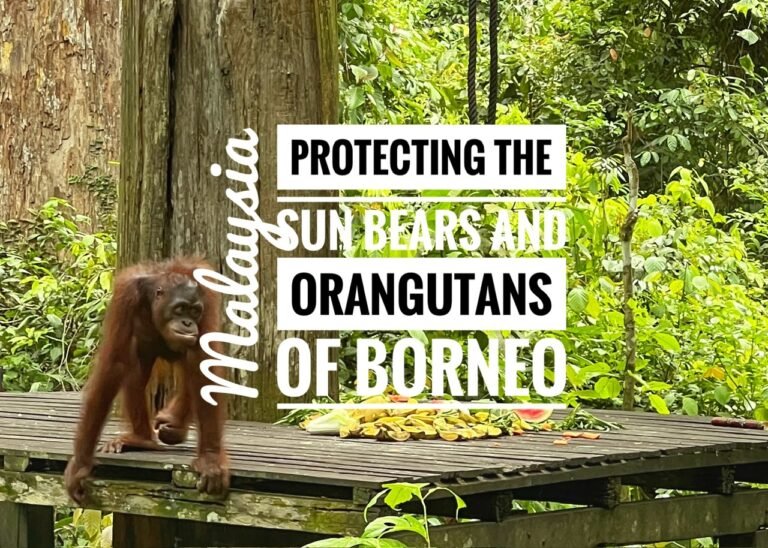
Night Six: Staying in a Ryokan
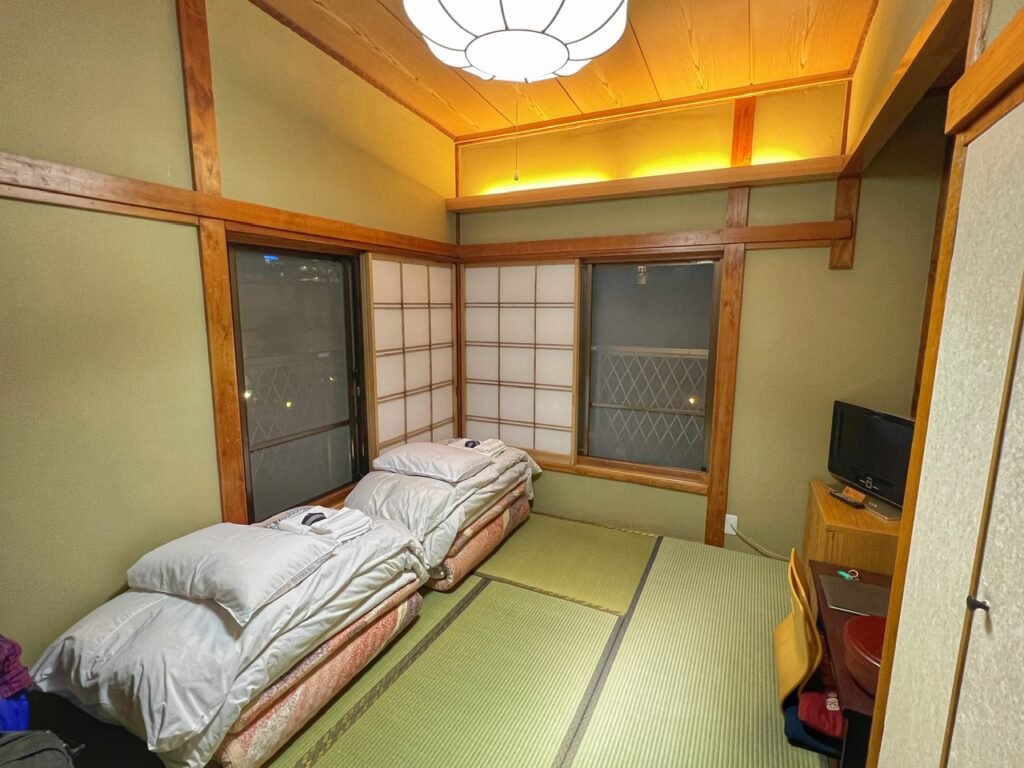
An absolute must on any Japanese itinerary should be staying in a ryokan, which is exactly what we did after returning from Snow Monkey Land. And although we had stayed in one the night before in Yamanouchi, we were also excited to know they offered such options in Tokyo as we found at Ryokan Sansuiso, which is an ideal place to stay during cherry blossom season because its located next to a river promenade, completely overflowing with them. It was also a great general location in the city. Ryokans are more expensive than other budget options and for us was a Valentine’s splurge at $63/night.
Ryokans are traditional inns that were set up in the Edo period (1603-1868) for lords and samurai warriors on the road. After a long day of travelling, the esteemed guests would bathe, enjoy a tea ceremony and have a long meal, washed down with plenty of sake.
They are characterized by tatumi mats on the floor, floor futons which stay folded up during the day, a small table and floor chairs used for tea ceremonies and luxurious shower/tub facilities. Although we didn’t find the facilities any better than our night at Shibu Onsen Kadoya near the snow monkeys, it was nice to know the experience existed in the city as well.

Our room had such a peaceful ambience, but it was a little too near the ever-present Tokyo subway to be totally tranquil. But the thing that really made this place was the absolutely warm and helpful staff.

Oh, and you also get an actually attractive kimono to walk around in as Mandy tries to show off in a mirror selfie having no clue how to do this. (The selfie or the proper way to wear a kimono.)



Our room had a TV, not that we’d ever turn it on at such a place, and the cutest little refrigerator ever.
When you’re ready for bed, you dress your floor futon, which are obviously a bit different for a westerner, but were amazingly comfortable. We’re just happy to be back in a land where firm mattresses are the norm after having a rough time in the States for weeks. The room also had floor chairs, called Zaisu, which are very popular in traditional Japanese houses.


Shower rooms included the best temperature and best water pressure, and all your amenities. The outside of the facility was located footsteps to a convenience store and supermarket. We quickly learned the best deals can be found after 8:00 pm at the supermarkets when they start marking everything down.
Day Seven: Shingawa & Sumida City

The next morning in the Shingawa neighborhood, we walked along the Meguro River and tried to visualize what it would look like in a month’s time when all the cherry blossoms had burst creating a canopy of pink over the river. We also regretted not staying in a “love hotel”, browsed in one of Tokyo’s more unique bookstores, dunked our chopsticks in the new age of conveyer belt sushi, watched the masks come off and the business guys go wild, and had our first official sake tasting.
We walked outside to discover another brilliantly blue sky and proceeded to walk along the Meguro for about 30 minutes. Although we wished we could have seen the blossoms, we were happy it wasn’t packed with tourists, only locals and their city-size dogs typically consisting of miniature poodles, Pomeranians or yorkies and all wearing nicer clothes than we own.


Amongst dozens of flawlessly pruned tree hairstyles, we did see lots of bushes displaying some very dapper Camelia flowers. Although these are common in early spring in the Pacific Northwest, we had never seen a striped one like this! Ooo la la!

A “love hotel” which comically looks like a castle. It’s no surprise the Japanese would want to work the fairy tale angle for their pay-by-the-hour motels.
So…if you’re westerner, you probably have a preconceived and possibly sketchy notion of a such a place. But there’s more to it than that in Japan. 70 years ago many families lived together with grandparents and children, Japanese houses are usually quite small so there isn’t that much space for intimacy. That situation spiked the demand for “Tsurekomi inns.” People started using the modern term “love hotel” in the early ’70s, which like many things in the ‘70s, it’s also when some of them became more sexual although often disguised by cheesy Las Vegas-style themes like Jurassic Parks”, “Ancient Greece” or “Spaceship”. (Guidance.co)
This particular European castle offered amenities like a dry sauna, jacuzzi bath, karaoke, air purifier, massage chair, darts, bathroom TV. Some also offer kinkier things to help in the love department if needed. You can rent them by the night or by the hour. This particular one was $65 a night, or the same price as our ryokan valentines days splurge.
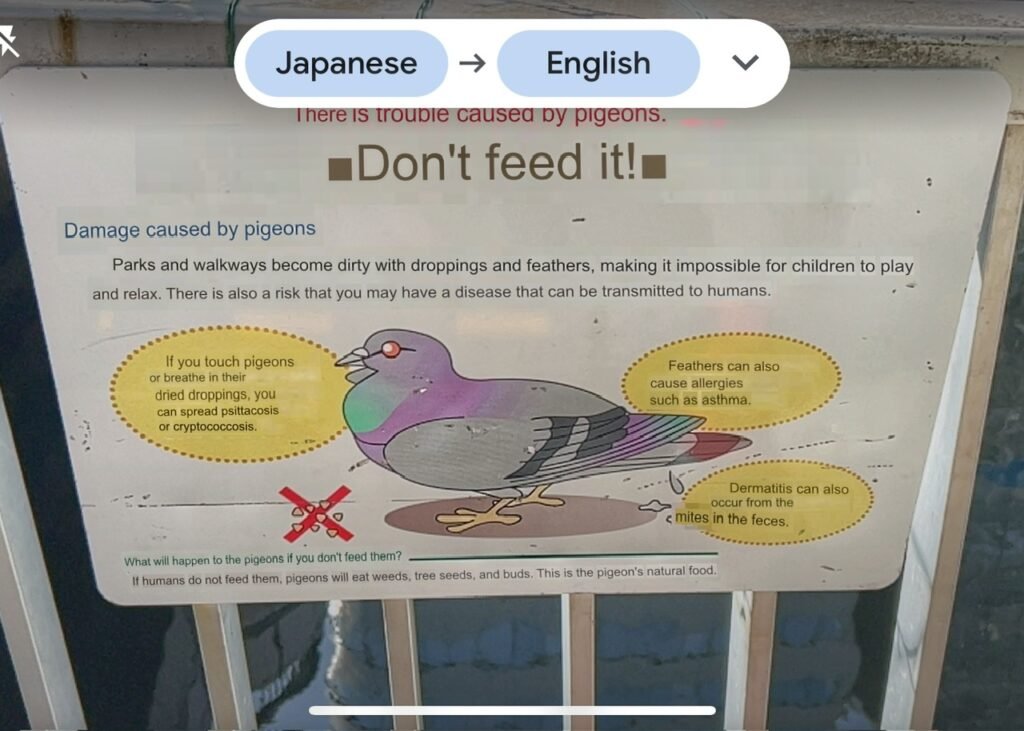
In addition to princess castles and princess pups, one could find the evil pigeons of Tokyo along the river. We’ve never seen such comical signage. We’ve also never seen a society so repulsed by these air rats (and have to agree with them after seeing the way people let them crawl all over themselves in Latin America.)


Tsutaya Books, which has an exterior resembling a picnic basket, is one of the more interesting bookstores in the city, we read. It was fun to see their selection of books on Portland, knowing how many tourists our city has always had from Japan.
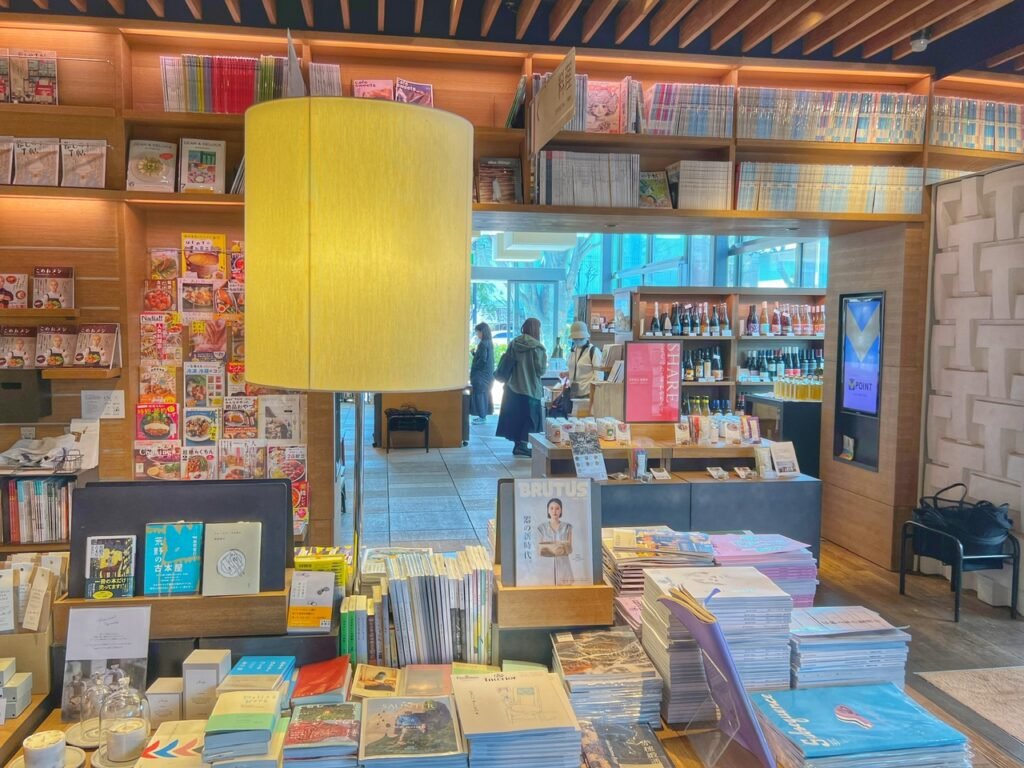

Also, the bookstore definitely had vibes of Powell’s, the mega bookstore in Portland. Starbucks in Tokyo, where no one ever talks loudly…or at all. This city is SO quiet.
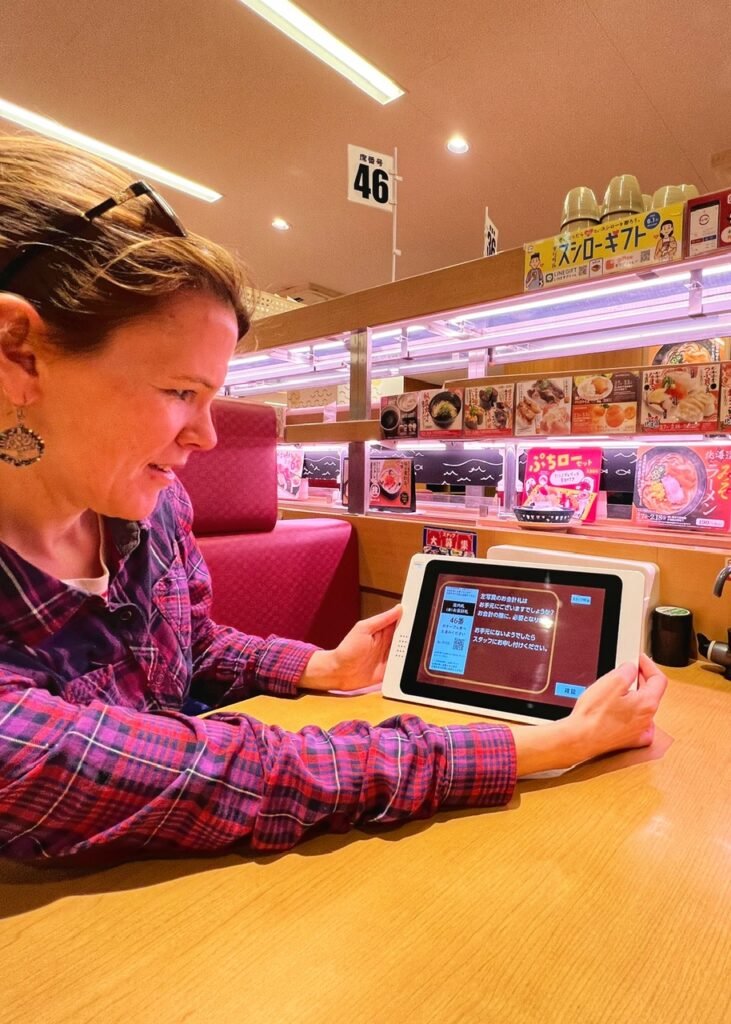

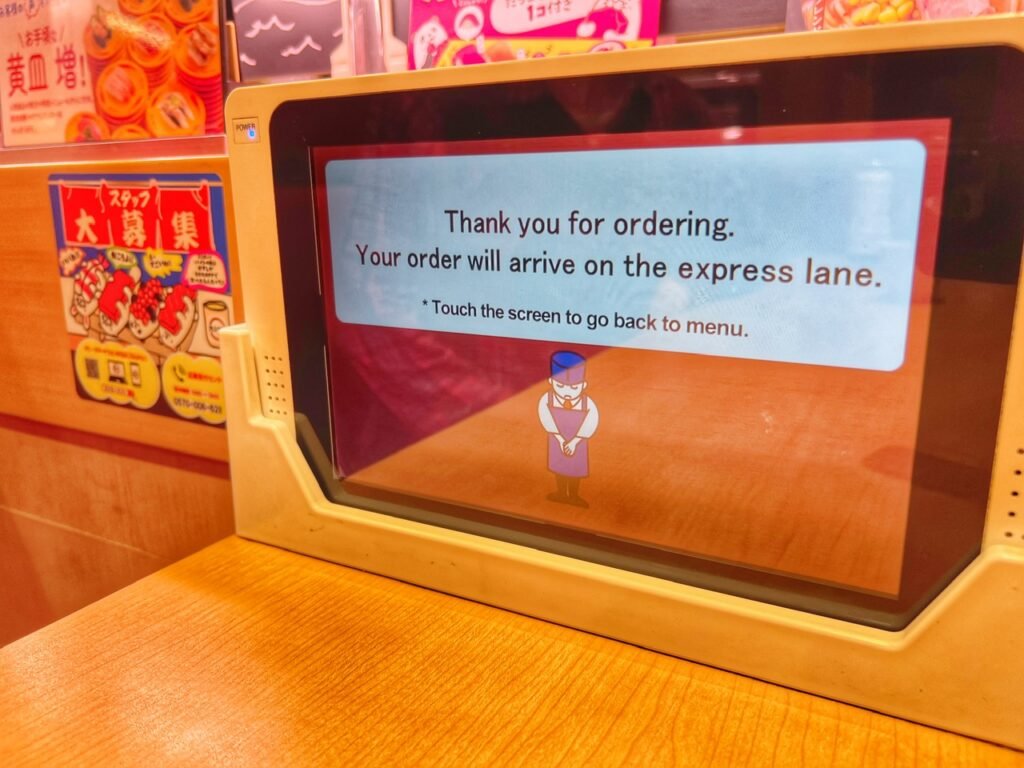
We then headed to our first sushi conveyer belt restaurant in Tokyo called Sushiro, where you order by tablet! Whee! How fun! Of the five sushi experiences we had, this was our favorite, and also the cheapest, style. There were soo many affordable choices! We ordered 10 plates which cost $12 and completely violated the Japanese rule that says you’re supposed to stop eating when you’re 80% full. But, you can only order four at a time!

While you wait, you can also chow down on the freebies like pickled ginger and green tea with a hot water tap conveniently located at your table.
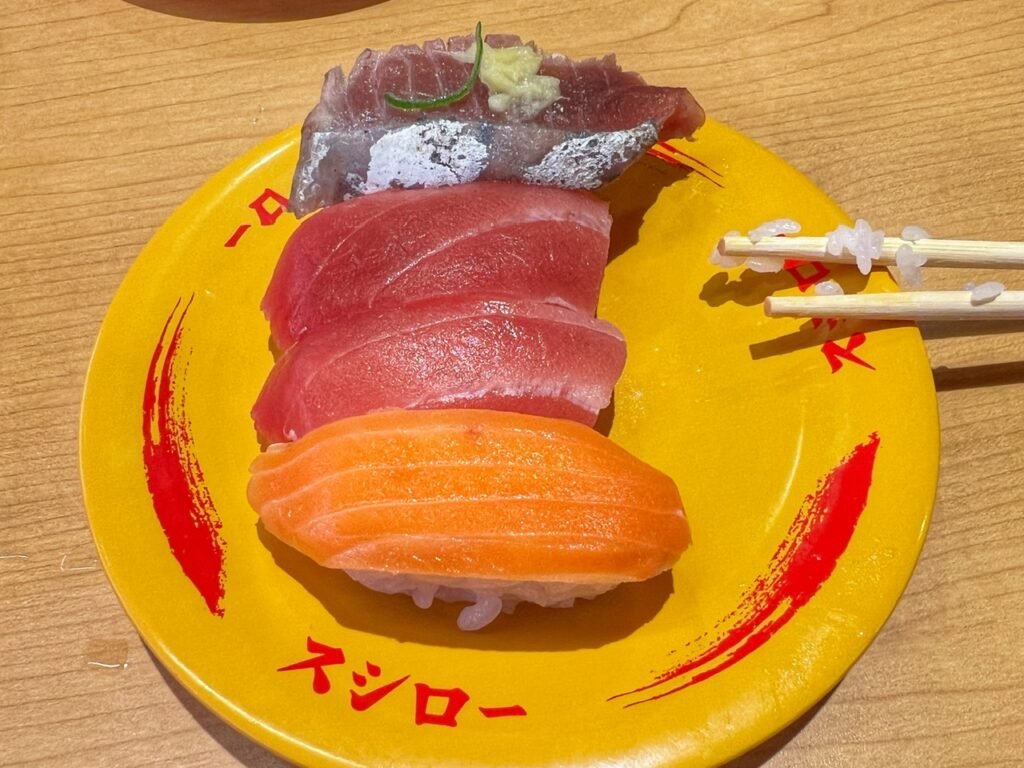


We can confirm…sushi from the source really is SO much better than anywhere else in the world. However, if you’re not such an adventurous eater, we appreciated that this restaurant had some more western friendly “starter sushi”’options. This one had grilled salmon, a bit of cheese, and a basil pesto sauce. It was bizarre having sushi that tasted so..Italian!! For the record, not one time did we see cream cheese in sushi or a BeniHana-style hibachi. Those are both clearly the complete American interpretations of Japanese. 🤣 Back to real sushi…or is it? This was a cucumber Kim chi version. So…Korean?


Mandy’s first fish eggs. She finally did it and if you missed the video, said it tasted like fishy couscous. 🤣We also tried Monkfish Liver. It was in a creamy salad form and actually pretty tasty despite the way it sounds and looks.
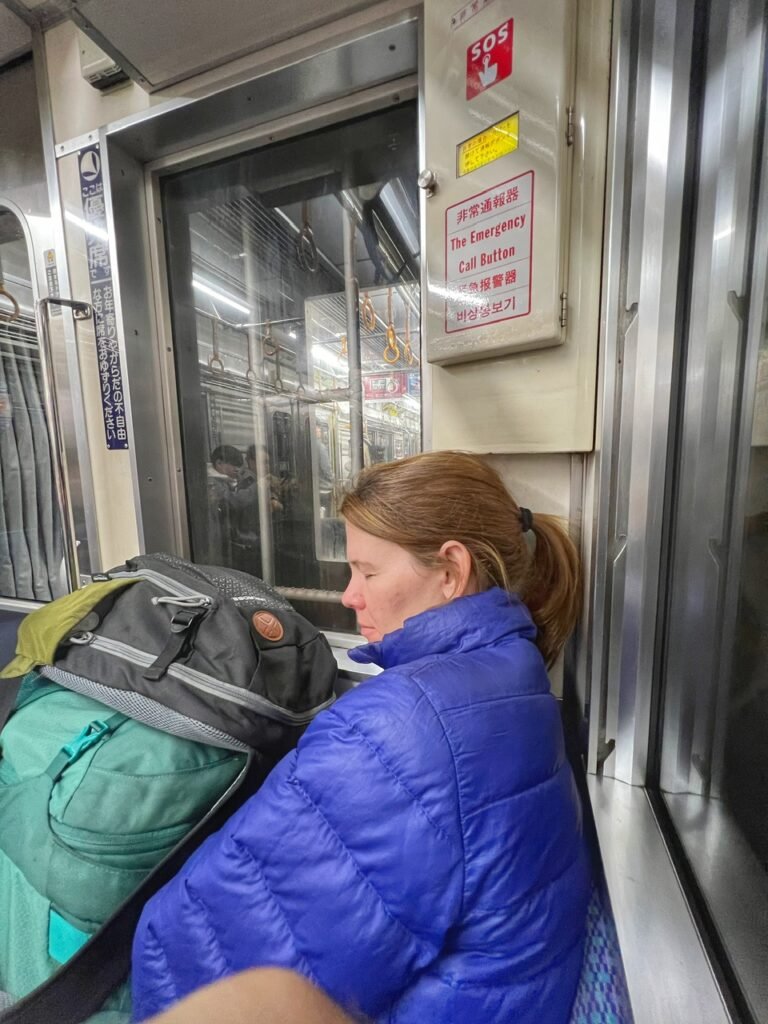
As we headed to our next place, after all that sushi, Mandy was happy to be in a place where it’s completely acceptable to sleep on the subway like the locals do. By the way, it’s also considered totally acceptable to allow your neighbor to sleep on your shoulder. About half of the people are usually in dreamland on the metro. The Japanese work very hard, and have demanding lives, so it’s no surprise.


Checking into what would become our favorite hostel of the trip at Wise Owl on the River in Sumida City which was our 6th accommodation in 8 nights. We were committing some seriously zooming travel for us. We paid almost full price for this private room which was $45 (Booking) but actually had space to walk around in unlike most. The hostel had a shared kitchen, bath and laundry, which cost 500 yen ($3.30) for a load to wash and dry…very reasonable. The hostel also had a huge cafe downstairs and lots of space for lounging and eating.

It also had an outstanding view of the 2000 foot sparkling Tokyo Sky Tree from just outside, but you did hear the trains going overhead about every five minutes if you didn’t have in ear plugs.

For dinner we headed out to a local joint for some noodles and gyoza and it was the first time we’d seen this size of a crowd of Japanese business people. There were three women in the sea of man suits. This is very common, and an almost obligatory practice, in Japan if you want to “get ahead.”
A local told us it’s quite common for men stay out until late or some just sleep in the city rather than going back to their suburban homes for the night. He also said many unsurprisingly have unhappy marriages, although divorce is still mostly socially unacceptable (1.2% divorce rate in 2023.) (wisevoter)



Considering that one of the Genes is our resident fermentation scientist, we had to make a trip to a saké brewery a priority while in Japan. At Heiwa Doburoku Kabutocho in Nihinbashi they specialize in one of the oldest (and more rare) saké styles, Doburoku, typically only served at festivals. All menus and ordering were done online through Mr. Menu.
Doburoku is unusual in that it is completely unfiltered, cloudy, and chunky…yes chunky…saké. More closely resembling porridge than traditionally clear saké, it is also sweeter. We tried the black sesame and yuzu (a Korean citrus fruit to start.) We enjoyed it!

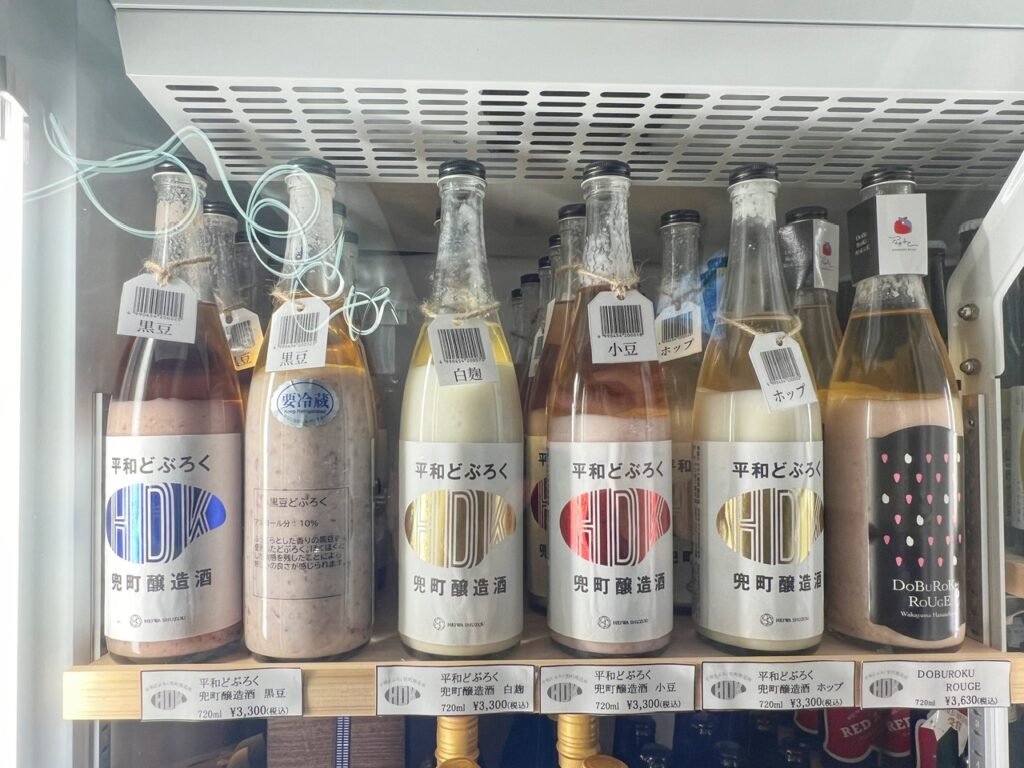
We also tried some made with red beans. Yes, it was a bit odd to have beans floating in your liqueur, but we like both, so figured why not?!
Interestingly, homebrewing of Doburoku has been outlawed in Japan since 1899 making the brewing of doburoku illegal without a special license. The liquor tax act outlines the punishment for brewing doburoku without a license in Japan, which is up to 10 years in prison or a fine of 1,000,000 yen!
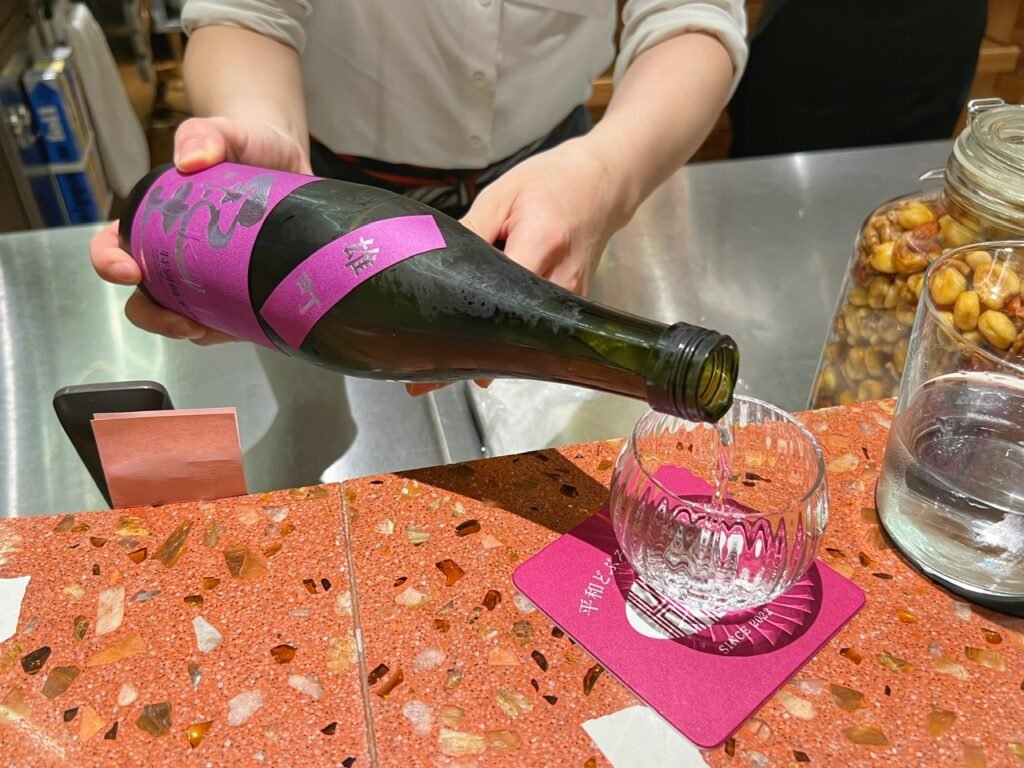

Next up, we had a more traditional style of saké, which was a clear, and wonderfully floral Junmai. Description according to the brewery, “Special pure rice sake Omachi using only carefully cultivated Michimachi, which we have created a clean and smooth texture from Wakayama. The vibrancy and softness typical of Kikuji emphasizes the strength and fullness unique to Shinmachi rice, creating a simple yet deep harmony. The gentle mouth and chin gently permeate the body, giving a deep full impression.” We liked it as well. It was definitely smooth and delicious. The total cost for the four glasses was $15 or 2400¥.
Day Eight: Akihabara Neighborhood (aka Fantasyland)

If Tokyo were Disney World, the neighborhood of Akihabara would obviously be coined Fantasyland. Its perpetual supply of vibrant color, zoingy sound effects and a dash of Doki Doki truly makes you feel as you’re cavorting through a video game. Plus, there are actual old school video games everywhere, and true to life Mario Karts zipping through the streets, not to mention endless anime, including the big breasted variety in a seven floor adult playland, a Japanese interpretation of a housekeeper to serve you, and secretive vending machines. There is clearly a lot of…ahem…action to be had in this part of the city. In addition to a labyrinth of curiosities, the streets of Akihabara are filled with Japanese and lots of English. The most common words seem to be game, maid and cat.

Even if you forgot your smart phone at home, you will never ever get bored here.

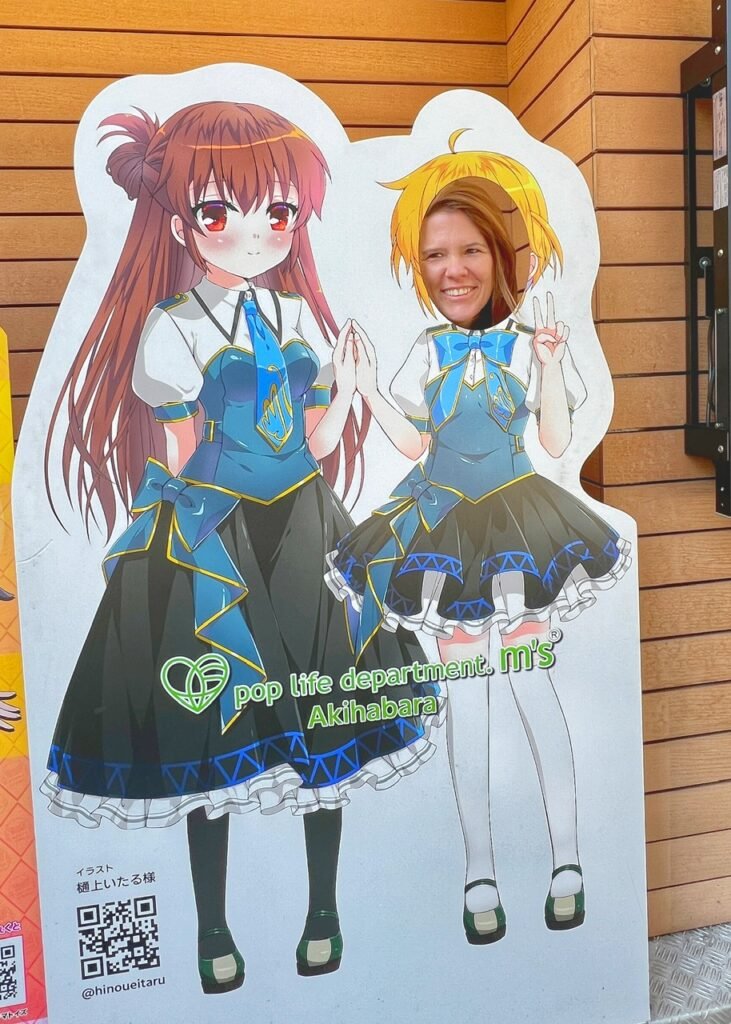

Mandy found an old and familiar friend. Of course back when they were buds she was so naive that she never made the connection that the Italian plumber, and the box you inserted him into, all in fact originated in…Japan. We also had a request from one of our friends for Mandy in anime, so here you go. In other forms of anime, do you think they make this in a 40L backpack home size?

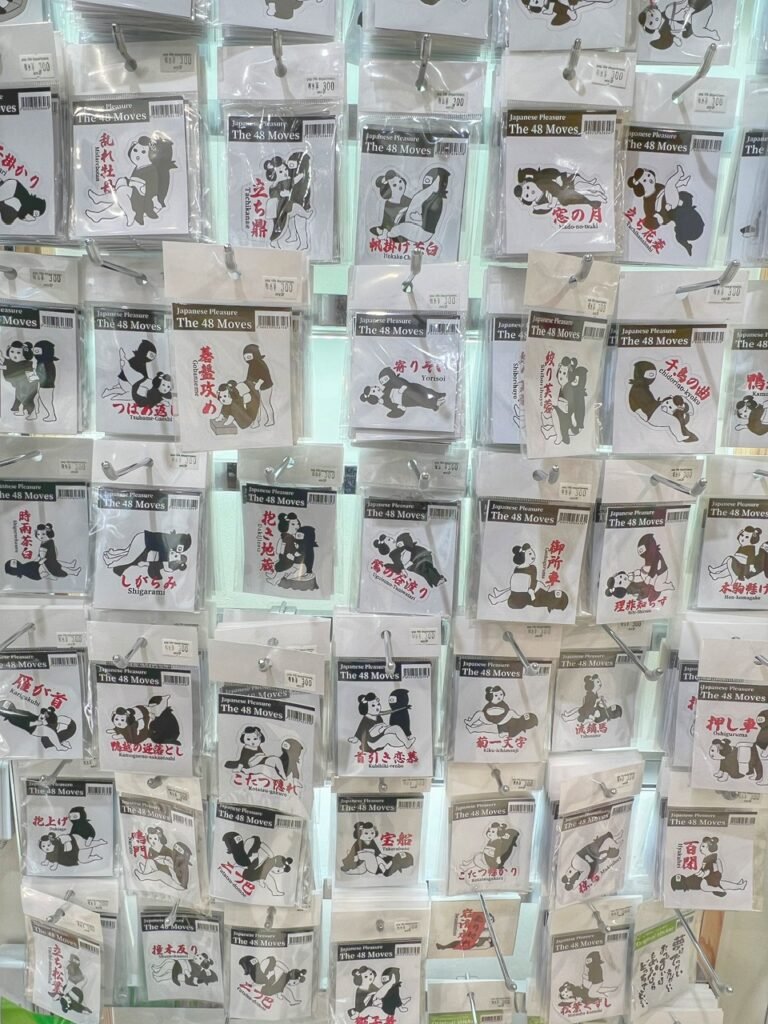

First we wandered into M’s: Pop Life Sex Department Store,” said by our guidebook to be most valued as a “cultural case study.” From the outside, the store looks rather innocuous. But when you walk inside and hear breathy high-pitched cartoon characters doing it, you’ll realize it’s far from that. It has seven happy-go-lucky floors of merchandise loaded with sex toys, lingerie, costumes, whips, chains, life-sized dolls, DVDs-basically every imaginable product catering to the frisky behaviors. It has seven happy-go-lucky floors of merchandise loaded with sex toys, lingerie, costumes, whips, chains, life-sized dolls, DVDs-basically every imaginable product catering to the frisky behaviors.
However unlike such stores in other countries, it seems a bit…for lack of a better word…normal…as you wander amongst the dildos and nipple clamps. Firstly, photos of real genitalia cannot be shown in Japan so that all becomes black boxed like an ABC reality show. Secondly, there is no pornography…except in cartoon form which is quite a…turn-off…at least to us. But clearly, it must float someone’s boat (metaphor intended) because there were a lot of local men gazing at it with deep indecision, a contemplative look of which Mandy has seen Greg have while looking at craft beer. Thirdly, the store is bright and airy, and weirdly feels more pure. Naturally, since this is is FB, and they could black box US, we will keep it quite PG-rated like these geisha/ninja Kama sutra stickers. Or, a warm place to store your spare change.

A friendly flow chart which tells you which toy is best for you. We cut out the actual toys at the bottom. Sorry.


Adult viewing in anime form. Ummm…ok. The “womanizer wave” shower head. Perhaps they meant womanizer wand? 😅

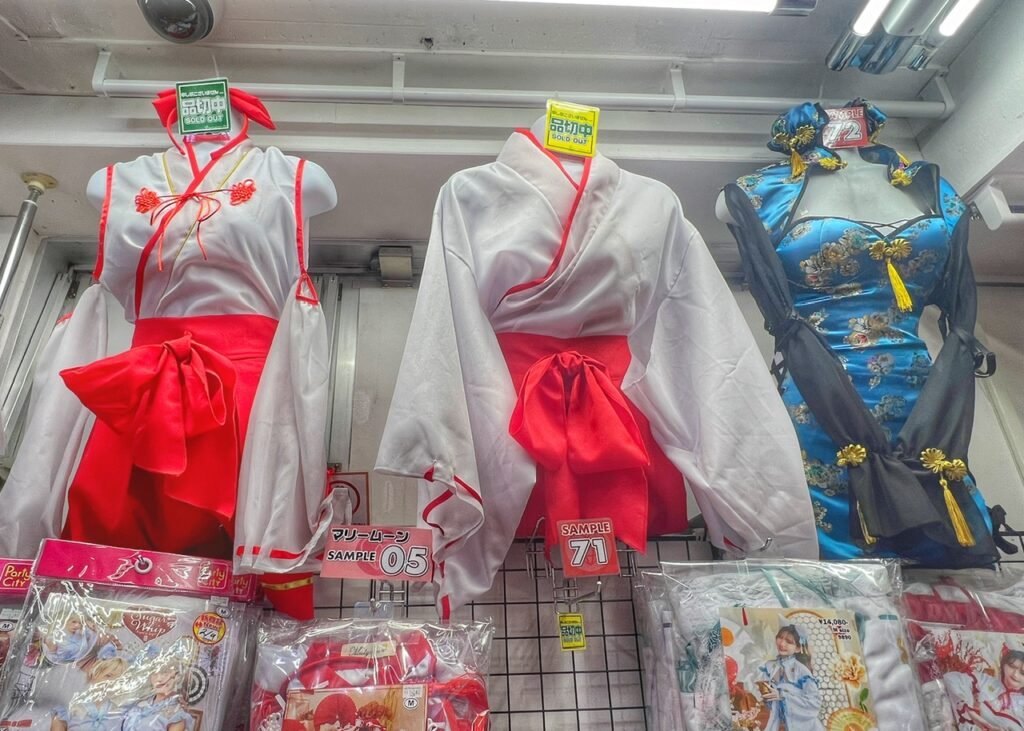
The Japanese seem to love to dress up! Apparently the school girl look is global? And actually have some very “cute” choices! Hmm…

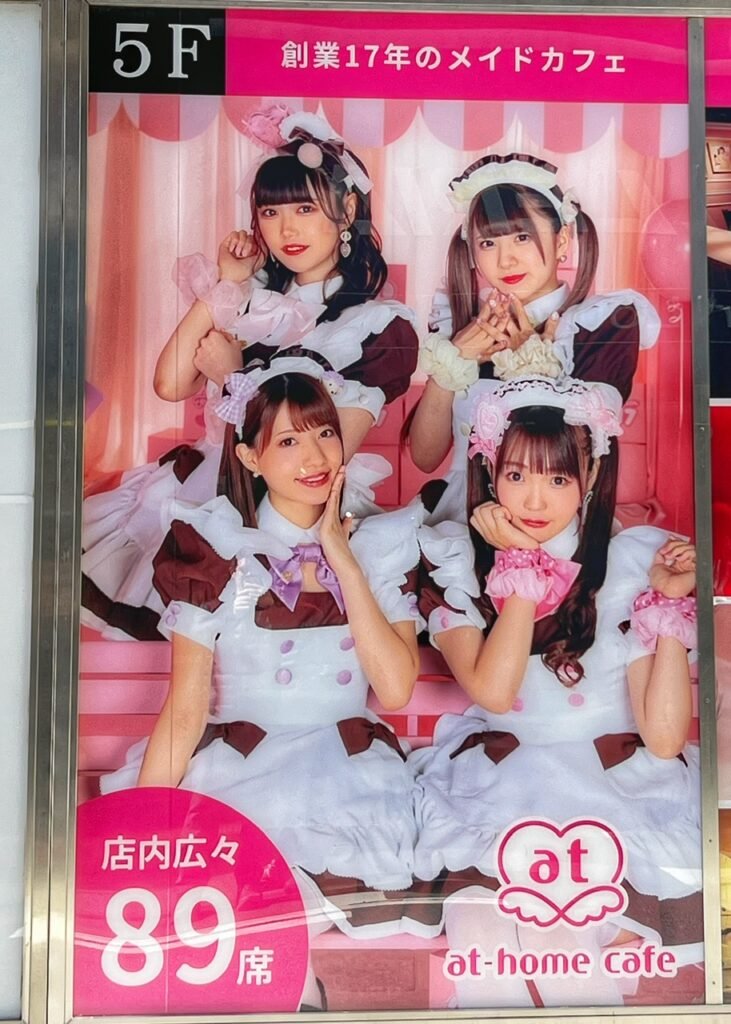
Moving on from the seven levels of sindom, we continued to encounter the “cuteness” and began running into some homely-looking ladies in classic French maid outfits handing out brochures for the nearby cafes.
Apparently when you go in one of these cafes “you’re welcomed ‘home’ by the bubbly, attentive waitresses who speak in high tones, kneel when they take your order, and sketch images like hearts and cats with ketchup or chocolate syrup onto the tops of omelets, waffles, and cappuccinos. There are a lot of warnings saying to not touch, photograph, or attempt to ask for the contact details of the maids, no matter how cutesy they may seem.” Ok…umm…at least they’re not in bright orange shorts with their tatas hanging out?
FYI, if you’d like to get your pillow fluffed, there is a $5 cover for this joint plus an obligatory food and drink order.


The street scene of Akihabara is quite a sight.

We noticed a here was a lot of King Kong paraphernalia in Tokyo. Is it just us, or is there a power play competition with Godzilla?


Speaking of fictional characters, there may be no better spot for retro video games on this planet than the radly named “Super Potato.” This secondhand video game megastore packs some powerful nostalgia for anyone who spent their childhood since the age of Atari, but particularly those born in the ‘80s. Even if you don’t buy anything, it was well worth stopping by to give honor to the icons of our youth.


We even found our favorite Nintendo games of all time!! What was yours? The fifth floor has old school arcade games for you to waste some yen in as well.
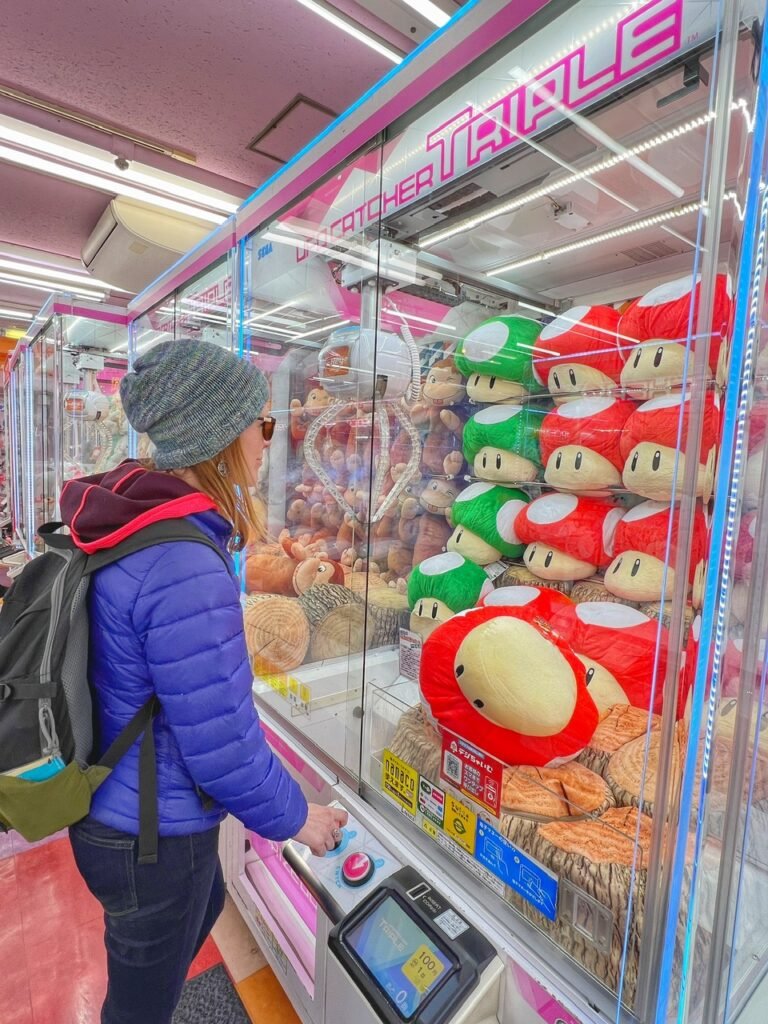


Wandering into a different five-story arcade, thank goodness Mandy lost the crane game. That magic mushroom would really not have been backpackable, but, that Cup of Noodles could really come in handy… Ooo…or we can learn to be a conductor of a Tokyo subway car!!

Or, yes!! Learn to be a Taiko drummer!! Unfortunately the game was in Japanese or we might have actually dropped some yen for this one!


What a magnificent, engrossing world!

For lunch, we took a much needed break from Japanese food and grabbed some veg curry from a mixed Asian foods restaurant called Sapana. It tasted amazing to us.
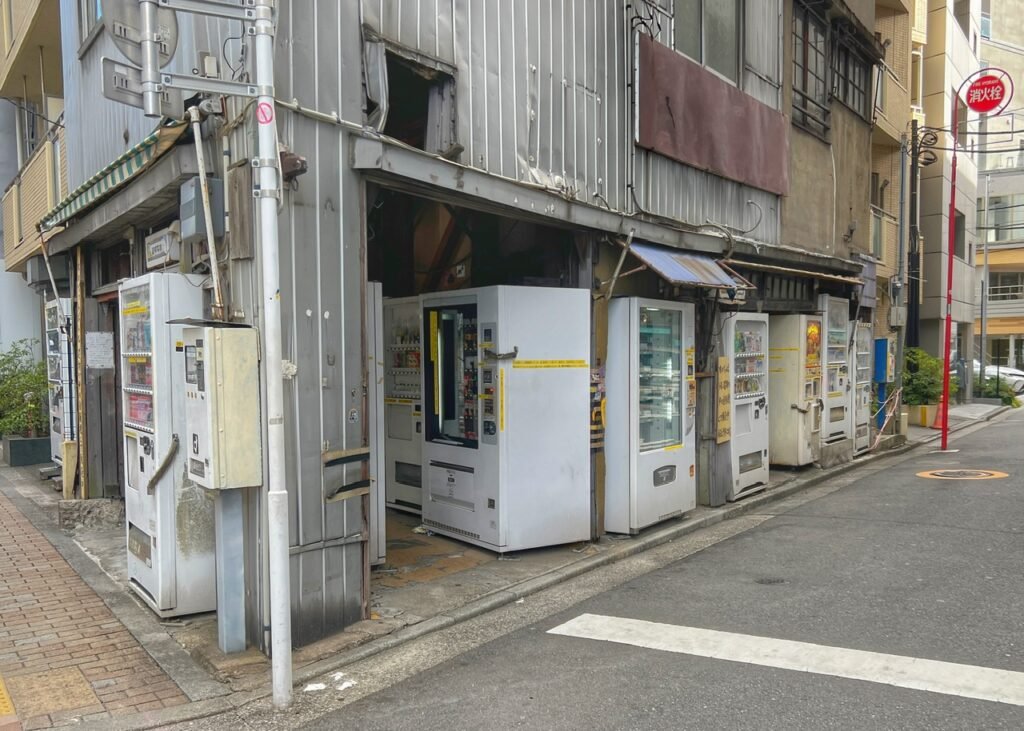
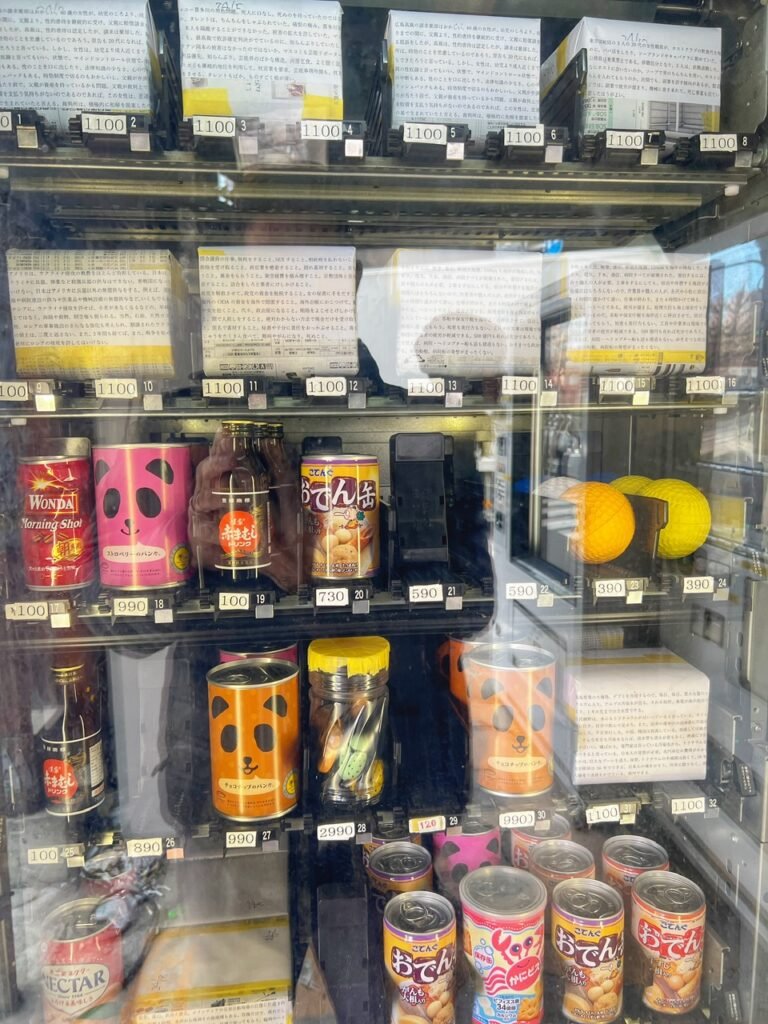

Next, we wandered over to the “Weird Vending Machines” which is actually how it’s marked on Google Maps. This cluster of retro machines has some very weird items in them. Of course none weirder (or grosser) than what we saw at M Pop’s earlier that day. The urban legend, which we couldn’t photograph, is true. There is indeed a capsule machine (not vending as some stories say) with women’s underwear in them. The soiled variety. Not the new variety. 🤮
In the cluster of “weird vending machines” we found some boxes with stories on them. You read the beginning of a story, and then presumably whatever is in the box finishes the story, should you be inclined to pay for it. An intriguing concept.



Who’s the creeper in the vending machine alley? And what the hell is that? See? Told ya. Google.

Despite all the debauchery we saw, we’d like to point out what seems to be a stereotypical Tokyo lady. Super classy and well dressed. This one looks like she emerged out of our great grandmother’s closet. Wow!!
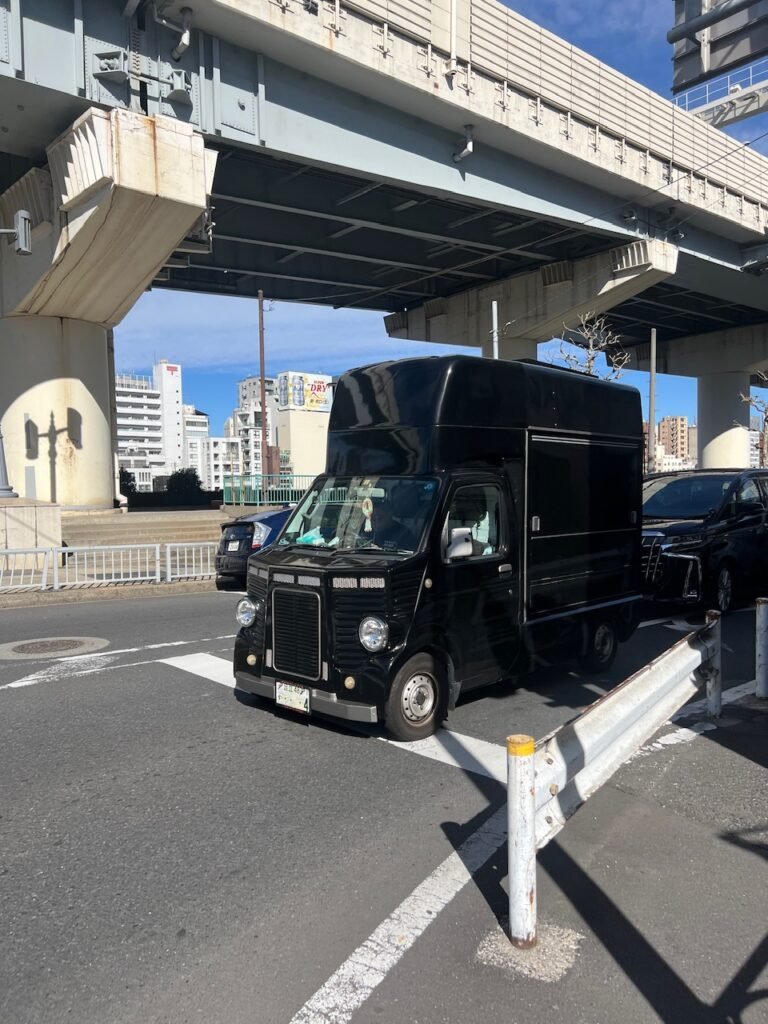

And a cute little truck. Just because. To get back to our place that day, we got to swing through the historic 1914 “western-inspired” Tokyo Station, which seems strangely out of place. Just like us…in Akihabara.
Day Nine: Shibuya Neighborhood

On our ninth day in Tokyo, we finally decided to venture into the busiest, most touristed and arguably, the most “Tokyo” neighborhood of all…Shibuya. Here we visited the people-watching mecca of Yoyogi Park, scrambled our way through the most congested pedestrian crossing on the planet, devoured the best sushi during our time in Japan, walked with awe through an eight-story mega department store and had a terrific homestay sharing beer and snacks with some new local friends, Riki and Aina.
Shibuya is to Tokyo as Times Square is to New York. And like in NYC, there are many places you can view the world famous Shibuya Crossing from up high, but most of them cost a pretty penny. Naturally, we found a way to do it for free in the Shibuya Hikarie building. Head to the 11th floor where you’ll find a fantastic view, a cafe and even a Lawsons convenience store.

Shibuya by day. This part of Tokyo is arguably the pulsing heart and soul of the city, and unmissable if you’re visiting the Tokyo area. It was easy to see the youthful vibe everywhere you walked and they even had Taylor Swift posters and music playing from loudspeakers with Japanese Swifty kids bopping around singing it, or pretending to, everywhere! Since most of Tokyo is actually pretty quiet, it was really energizing and different.


Of our six sushi experiences, Uobei was our favorite and also the most affordable. As you walk in, you are assigned a seat number by a robot, which has a corresponding tablet order screen amongst the library-looking rows and rows of sushi diners. Above you are two sushi treadmills. One for condiments, and the second one where your order magically appears at the poke of a touchscreen. As if in a library, we also found ourselves not interacting much as we absorbed ourselves in our individual tablets. So…like a normal dinner table these days. It would be perfect for a solo traveller because it’s also a bit isolating without feeling awkward.
We got about 12 plates plus Udon noodles which came to $15. As always, ginger and green tea was complimentary so if you’re really a struggling backpacker, you could just chow down on those things. We’re cheap. But fortunately we’re not that cheap.

We liked Uobei the most because it had a giant selection and you weren’t a slave to what’s on the sushi mover. There were not only traditional nigiri rolls (sushi) and gonkan (seaweed wrapped) rolls, but also things like udon noodle dishes. In this photo: 1) grilled and raw salmon…always our favorite 2) udon noodles with shrimp tempura (fried) 3) Inari sushi, which is vinegared rice tucked inside sweet and salty deep-fried tofu pockets. It’s one of the few vegan/vegetarian types of sushi there are. Japan, even here in Tokyo overall seems like it would be very difficult for full-on vegetarians/vegans. The gonkan at right is tuna salad with pickled peppers over rice. Very nice.


The Shibuya neighborhood alone has 228,000 people living in it. Now we get why they call their neighborhoods “cities.” If Shibuya was a city, we wandered into a neighborhood in the 8-story department store called “Hands,” which we thought was the best…”Cool! Look at this!!” shopping experience in Tokyo. They truly think of everything here. Zoom in to check out their floor map. We spent almost an hour in the health and beauty sections.


Makeup. For men. Sexual orientation aside, this is very much a thing in Japan. It’s been popular for teens for quite some time, but is now catching on for the middle-aged guys like Greg. As open-minded as he is, he decided it was a negative. Also, beards are rarer in Japan as they prefer a clean shaven look. Cosmetic marketers rejoice in Japan!
Masks, masks, masks. The selection makes it a true fashion accessory in this country.…for years before COVID, but now even more so. People wear masks in most cases to avoid passing on germs to other people. Also, a large number of people in Japan put on masks in public places even if they are not feeling unwell so they don’t get sick…period. Gee. It’s as if they actually LEARNED something from the pandemic?! 🤔


The store was called Hands. So we might as well stuff our mitts in this hole for an at-home hand massage. Oh wow!!! (Don’t worry, sanitizer is also available every two meters.)
Or, if you need other extremities pampered, they have every kind of shoe insert and foot product imaginable. There were even some Americans in there complaining about their crappy shoes and aching feet. Needless to say, this could have come in very handy for us with all our previous foot problems.


Once you’ve taken care of your hands and feet, they’ve got massagers for all the other body parts too, including this nifty contraption for headache and neck pain. Another one Mandy could have desperately used in her past.

Today, as we headed into Yoyogi Park, she’s happily headache free enjoying her vending machine milk tea.

Although we knew we’d get some plum (ume) blossoms in February, we unknowingly stumbled into Yoyogi Park where we encountered kawazu cherry blossoms on the day before they were forecasted to be in full bloom. These early-blooming blossoms flaunt radiant showers of princess pink just as magnificently as the March ones, so we were ecstatic to participate and completely captivated. It was not only a show of color on this grey day, but energizing to watch the stunning local princesses, including the canine variety, as well as catch glimpses of unanticipated parrots squawking in the trees.

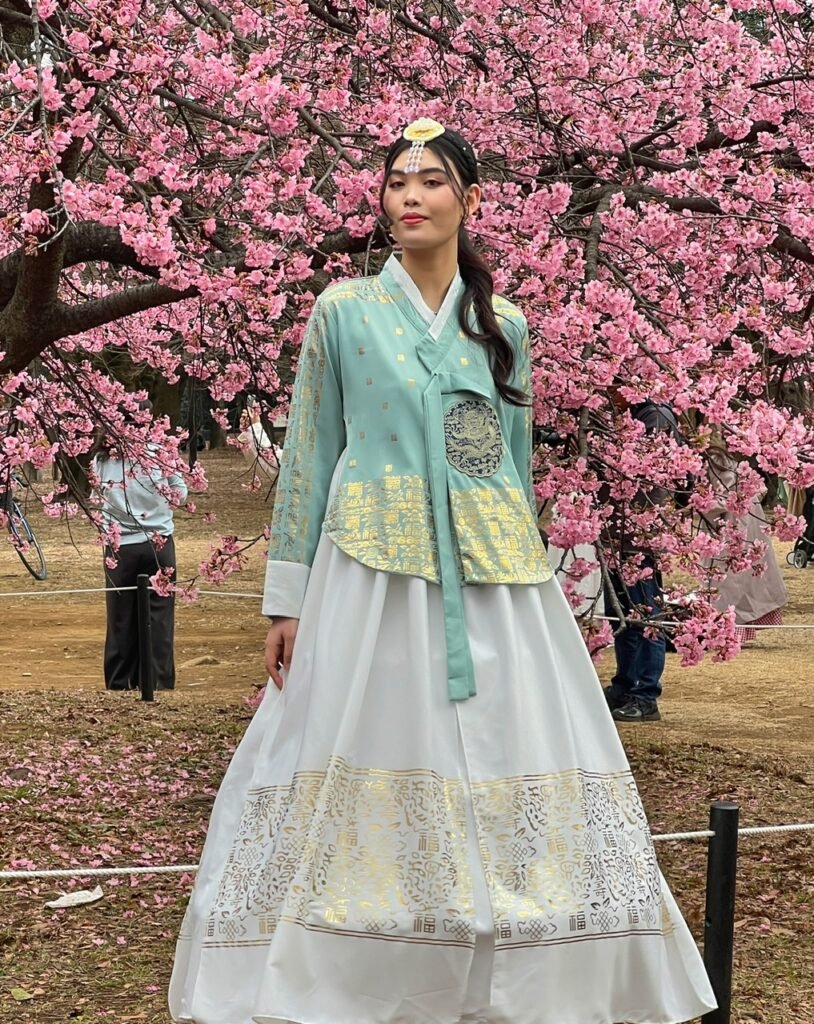
We were lucky to see two brides doing photo shoots while in the park. Of course, this stunning young woman looked more like an empress.


The official national cherry blossom season in Japan runs from mid-March through mid-April. The Japanese ladies continue to wow us with their class and elegance.
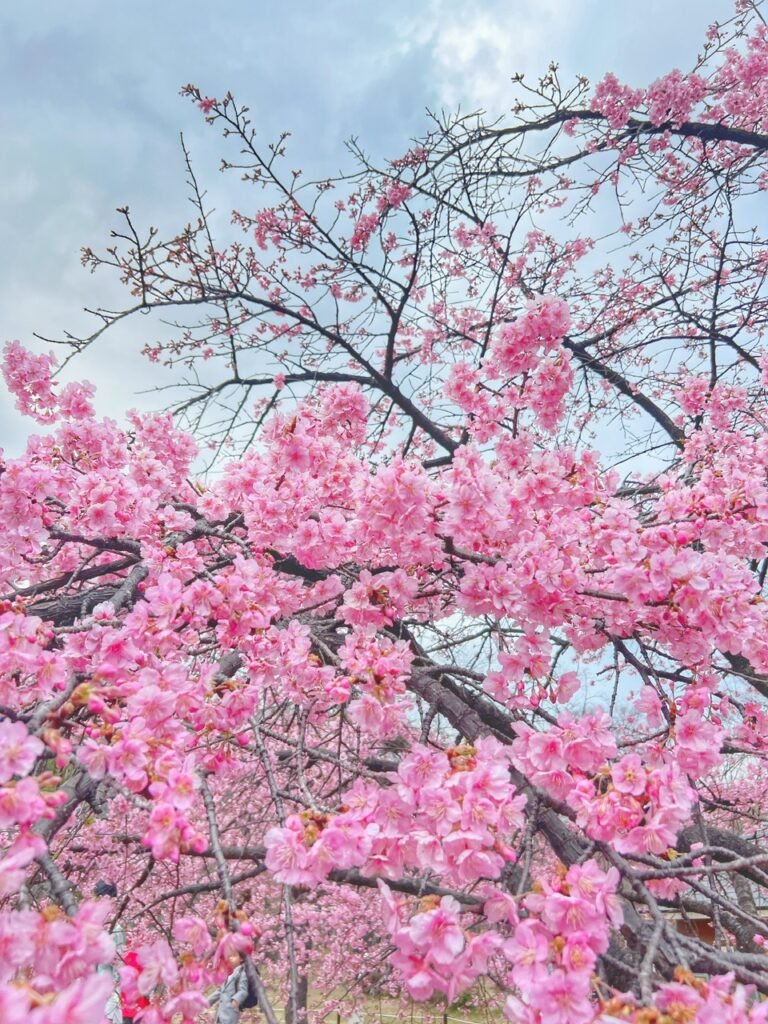

So what do the cherry blossoms represent and why are they so important to Japan? According to the Guide to Japan, “as the coming of spring promises new life, so the blooming of cherry blossoms brings a sense of vitality and vibrancy. At the same time, their short lifespan is a reminder that life is fleeting.” What a perfect reminder to seize the day.

As does this one with her monster muff…

…and the Pom princesses. It was absolutely hilarious to watch the locals try and assemble their fluff monsters for a family photo.

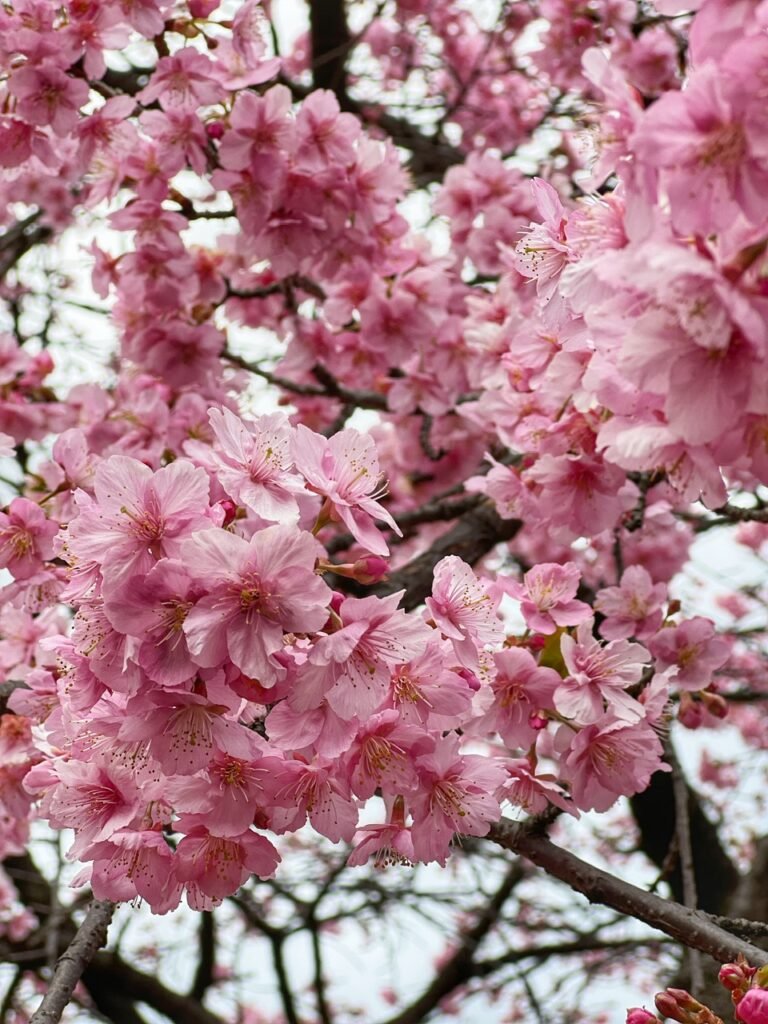
Historically, the blossoms, called Sakura, represented the brief, but colorful life of the samurai, warriors of feudal Japan. They lived by a strict moral code of respect, honor, and discipline — called bushido. Fallen cherry blossoms or petals symbolized the end of the samurai’s short lives.”(Guide to Japan).
“During World War II, kamikaze pilots also marked their planes with sakura before embarking on suicide missions. These emblems symbolized dying ‘like beautiful falling cherry petals for the emperor’.” (Guide to Japan.) We’re beginning to understand why the cherry blossoms in Japan are very different than in other parts of the world.

An adorable young samurai suits up. He’ll grow into it anyways.

But what we didn’t expect was a flock of parrots contrasting the pink perfectly in the trees and devouring all the sacred cherry blossoms. Apparently feral parrots were let loose after an exotic pet craze, and have taken over the world’s largest city. According to the Audubon Society, “these birds are descended from parakeets brought to Japan by the global exotic-bird trade in the 1960s and ’70s; initially in fashion as pets, they were eventually turned out by owners who couldn’t handle the garrulous, hyperactive birds and their expensive niche appetites.”
Ugh…. More point deductions for humans in the humans versus nature war.


We are so very pleased we got to see this beauties! They are truly showstoppers!!

As we walked away from the park, we discovered less clothed, but more flawlessly coiffed and cartoonish streets trees.

Visiting the 11th floor of Shibuya Hikarie. We got there at about 5:30 so decided to grab dinner so we could admire it at night as well.



Naturally dinner would come from Lawson’s on the same level, the favorite convenience store of many tourists although we believe that the Japanese scripted “My Basket” is better, and far cheaper. Convenience store dinner that night included a reasonably healthy salad, sweet potatoes, and a noodle bowl for $5.63.


We admired the Lego replica of parts of Shibuya City, and noticed how much more diverse this toy population looked than the real deal.

Shibuya Crossing at rush hour. Notice how many people and how few cars. Everyone is heading to or from a metro line which are positively jammed. We experienced it one time at 6 pm with bags on and the congestion compared with some of our most horrific rides in India, but without the smells, obscene sounds and pushiness. Even when you’re crammed in like sardines, everyone is still as polite as can be. And when they see our Euromutt faces, it’s always, “sorry” if they accidentally bump into you.

After checking out Shibuya Crossing from far above, we retrieved our bags where we had conveniently stashed them for the day at Shibuya Station. These luggage lockers are one reason we were able to move easily throughout the city and the cost was insanely affordable…$3.33 for up to THREE days, which would be unheard of in Europe.


From here we swung by PDX Tap Room Brewery to get our couchsurf hosts a gift from “home” (a Japanese custom when you visit someone’s house) and the regular market to pick up some local beers. We did not buy this one, but thought the diminutive size was adorable. We did buy one that was tomato flavored, which was like a Bloody Mary meets beer. Bizarre. Beers were about $1.25 each for the national brands so pretty affordable in a market.

At the end of the day, we stayed with new Couchsurfing friends, twenty-something’s Riki and his girlfriend, Aina who graciously opened their super tiny apartment and allowed us to stay on their living room floor. It was not easy to get couchsurfs in Tokyo, although we put in at least ten requests. So happy these two said yes, however, because they were really interesting and sweet.
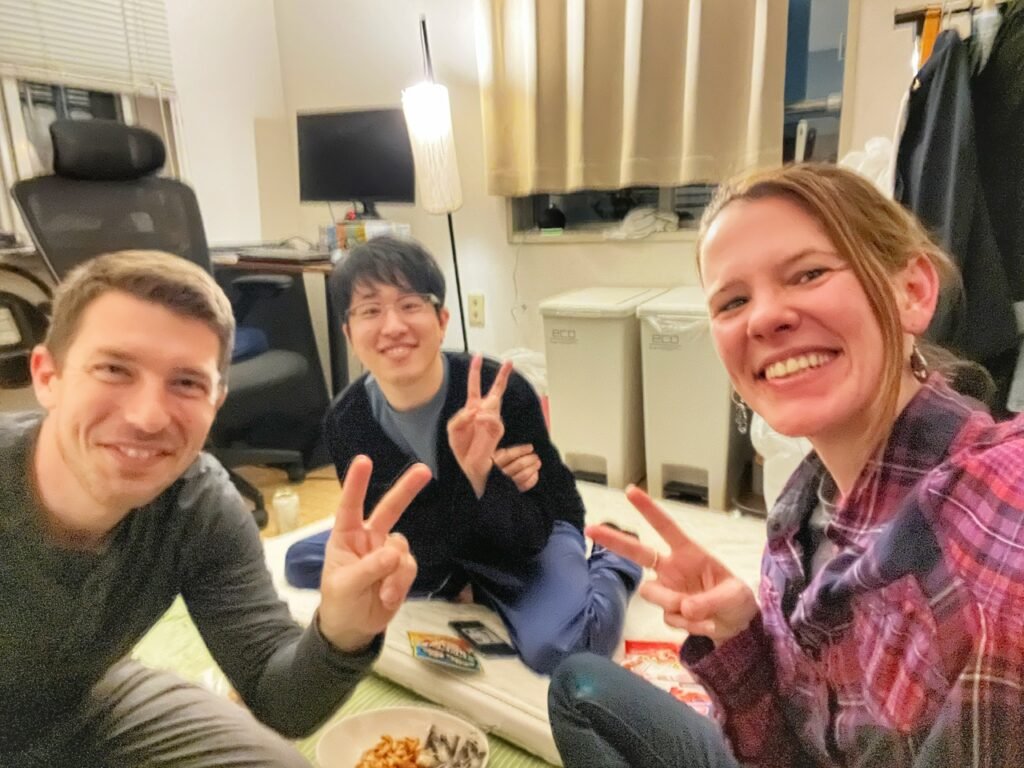
Arriving to Riki’s, which was so quiet we didn’t even need ear plugs despite it being a 15-minute walk from the heart of Shibuya. Riki and Aina also shared lots of new beer snacks we would never had tried otherwise as we chatted.

We talked for hours about travel, and Japanese and American customs. As are most people, they were astounded by our gun laws. They also answered our questions on bowing, (because it often felt like a “you go, now I go” competition to us,) and societal norms in Japan. They were also very surprised to know that the Japanese concept of “Ikigai” was trending in the US because this “reason to live” philosophy is not actually something that they grew up learning about, although we have certainly noticed work pride being prevalent in Japanese society. We’ve never seen anyone sweep the stairs, stock shelves, serve food, or fold the toilet paper roll with such precision and care like they do in Japan.

Saying sayonara the next morning. We had such a great time with our new friends and feel so lucky to be invited into their Tokyo home. Couchsurfing is truly the greatest! Not to mention, back-to-back free accommodation on the most expensive night of the week (Saturday.) Undoubtedly a win-win!
Day Ten: Yanaka, Akihabara & Our First Capsule Hotel

After days exploring the bustling areas of Shibuya and Akihabara, we were due a bit of quiet, so we headed to Yanaka which is known as a more historic, residential and peaceful neighborhood of Tokyo, which felt very authentic and far off the beaten path from the tourist crowds. It has a pedestrian street which feels like it fell out of mid-20th-century Tokyo, the largest cemetery in the city, and an abundance of temples and shrines, some relocated from around Tokyo during an Edo-era episode of restructuring. That day we also wandered back down to Akihabara to meet up for craft beer with a friend, some Chinese food and some fish stuffed to the gills with creamy custard.
Sunday was a great day to be in Yanaka because almost all the vendors were open. Yanaka means “middle of the valley,” because it is situated between two hills (Ueno and Hongo.)


This included the typical fried food stands, stores devoted to felines…

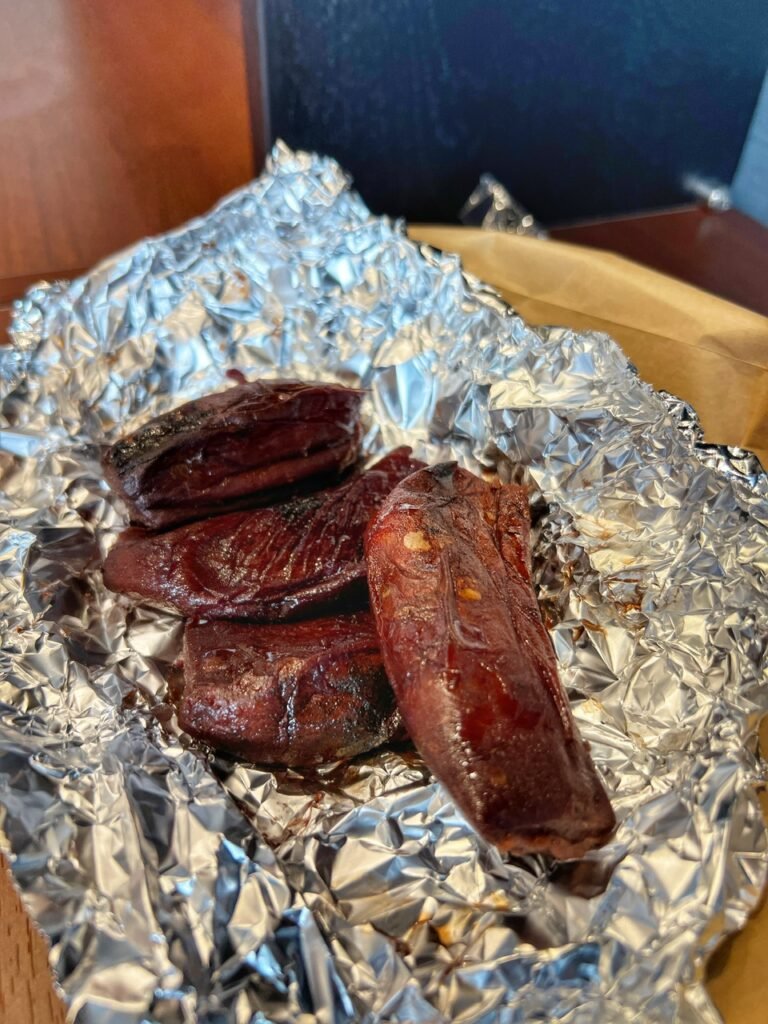
…and sweet potatoes, which are eaten like the dessert delicacy they deserve to be in Japan. Four minis cost about $2 and served as a perfect mid-morning snack.

According to a blog post, these stairs are the pulsing heart of Yanaka and typically filled with joyous people. The concrete mass wasn’t particularly joyful or pulsing in our opinion but maybe it just likes to sleep in on Sunday mornings.

Honritsu-Ji is one of the many temples that dot Yanaka.



It’s notable for its fire engine red gate, cherry blossoms, and massive cemetery with objects that look like snow skis accenting the tombs. Pretty sure they’re not snow skis, but it was very a unique feature we saw while in Japan. Anyone know what they actually represent? Yanaka Cemetery hosts the graves of many famous people including artists, writers, actors, scholars and statesmen.


A bold sash accessorizes this temple. This copper seated Buddha was created in 1690 by Ota Kyuemon.

Walking from Yanaka, to Ueno to Akihabara we decided to mix it up and have our first set Chinese meal in Japan, which was a set meal of cashew chicken, egg drop soup, pickled cabbage, and tea. It was about $5/each.
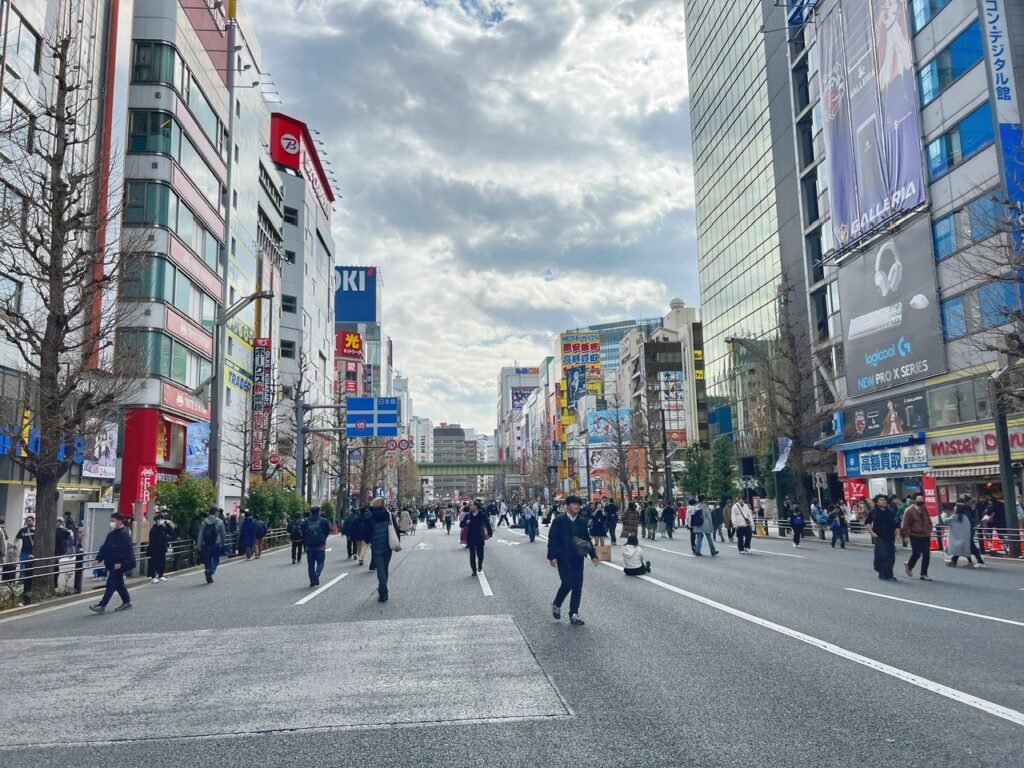

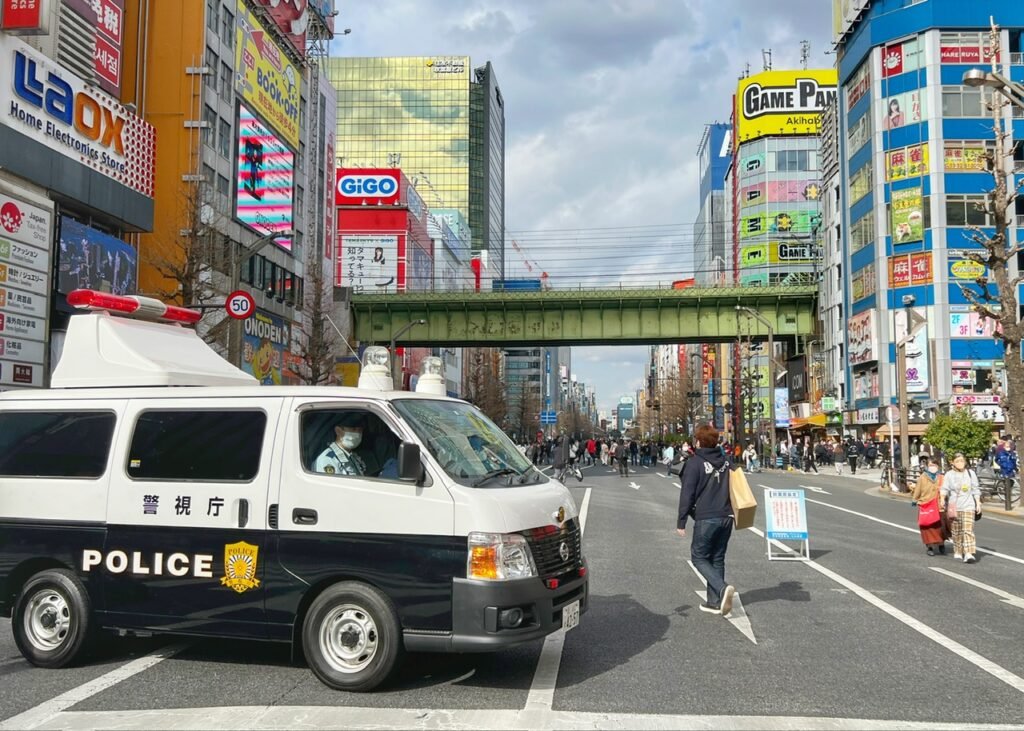
Meandering further into Akihabara, we discovered we can walk out onto the streets because they are blocked off! How fun! Classic Tokyo, where the little police vans look like Lego cars.


Heading to our first, and only craft brewery in Tokyo called Hitachino where we spent $20 on three beers. Considering we just spent $25 on the same in Portland it still puts Tokyo as cheaper in this department. Of course, here it was without a tip. (Because in Japan, it’s considered rude not because of our frugality!) The selection was quality, however.
Yes, we’ve fully adapted to the Japanese peace sign. 🤣It was here we met up with Adrianna, a friend Mandy went to Indiana University with who has been living in Japan for 11 years. Was so interesting to hear her perspective on living there as well as ask some questions we’d been having about the language and culture.


After this, we indulged in our last taiyaki, or pastry fish stuffed with custard which has been sold in Japan since 1909. Fish are a sign of good fortune. At this shop, the custard was fresh off the griddle, super hot and oozing. After having a portion that burned her tongue, Mandy proclaimed after that she preferred the colder, and floppier version from 7/11 while Greg liked the mouth-scalding, oozy version.
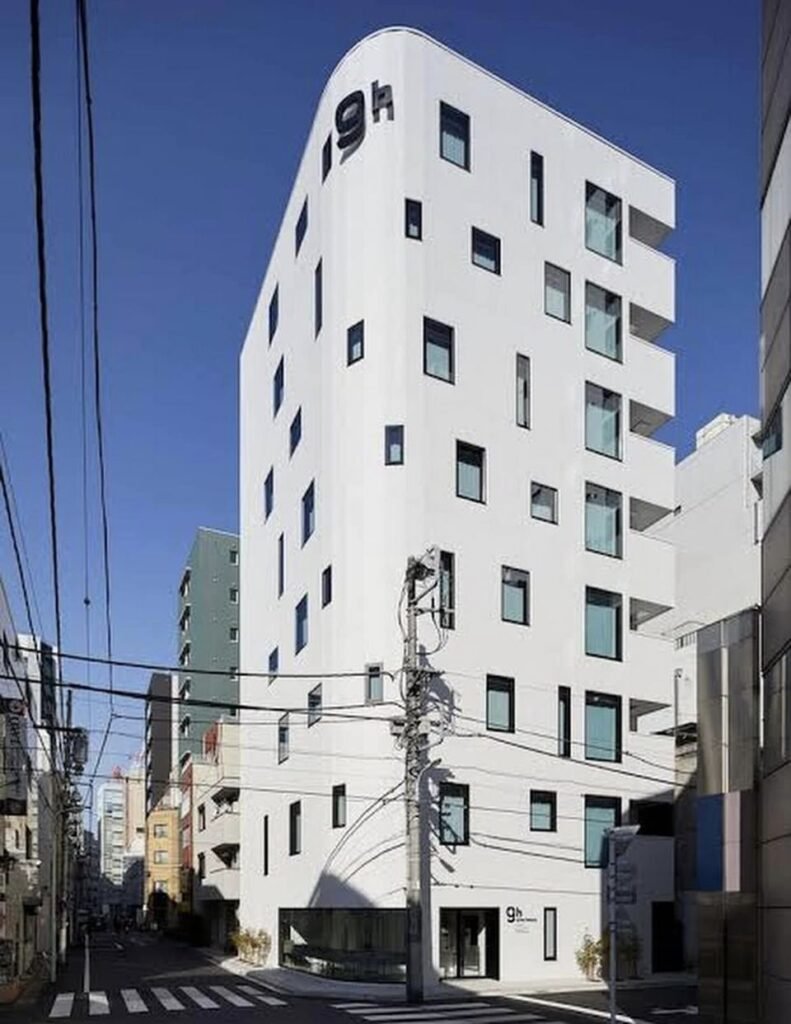
After our teriyaki, we headed to our home for the night…a space age pod. Originating in Japan, the capsule concept has now evolved and spread to countries across the globe. So of course, our “budget” trip to Tokyo would not be complete without the ultimate Japanese lodging experience of falling asleep in our very own spaceage bed bubbles. With a reasonably comfy sleeping situation, dimmer light, charging station, amenified showers, and lockers for your belongings, the capsule hotel takes hostels to another level and has everything a budget traveler needs after a long day of sightseeing.
Or does it?! Our experience in our first capsule was a bit of a love/hate conclusion….

Capsule hotels have become commonplace thanks to Japanese businessmen who worked, or stayed out drinking with coworkers too late, to catch their last train home. In this regard a hotel like Nine Hours, where we stayed, makes sense. One hour to get settled in, seven hours to sleep and one hour to shower and get ready. (For the record, they actually give you 19 hours from 3pm-10 am and will hold your luggage before and after, although we have no idea what you’d do there for that long.)
That said, the nine-story hotel itself is truly designed for sleeping and not really designed for a traveler. In fact, we’re not sure the architect has ever traveled before in his life. If he had, he’d realize that a teensy lounge with more than four uncomfortable chairs and a place for both genders to congregate is essential. He would also not put the only showers on floor two when all your stuff is on floor eight with teeny-tiny elevators. He would also realize people need a place to sort and reorganize their luggage. A tea kettle was also noticeably missing, which is an essential item in Japan (and most places.) Rant aside, he did provide a pretty dope place to sleep.

The sleek two story pods with floor LED “room” numbers make you feel like you’re climbing into the hibernation capsules in 2001: A Space Odyssey, only instead of HAL waking you up, it’s your neighbor. Although the MRI-esque chambers may appear sound proof, they only offer a uselessly sound-blocking pull down shade at the opening. But, the pod walls themselves seem to be pretty snore-blocking. So, like any co-sleeping nest, ear plugs are essential.

When you arrive to Nine Hours you are greeted by a robo front desk staff to check in. This machine takes your passport information and prints out your card which gives you access to the facility.
We booked our capsules through our annual Chase Sapphire Preferred $50 credit freebie you get annually, which cancels out half of the annual $95 fee. With this credit the two pods cost $8.
(P.s. If you don’t have Chase, it’s one of our favorite cards. They are currently offering a 60,000 sign-up bonus after a minimum spend. We invite you to use our link if interested!) https://www.referyourchasecard.com/19l/X4TWECG3QB)
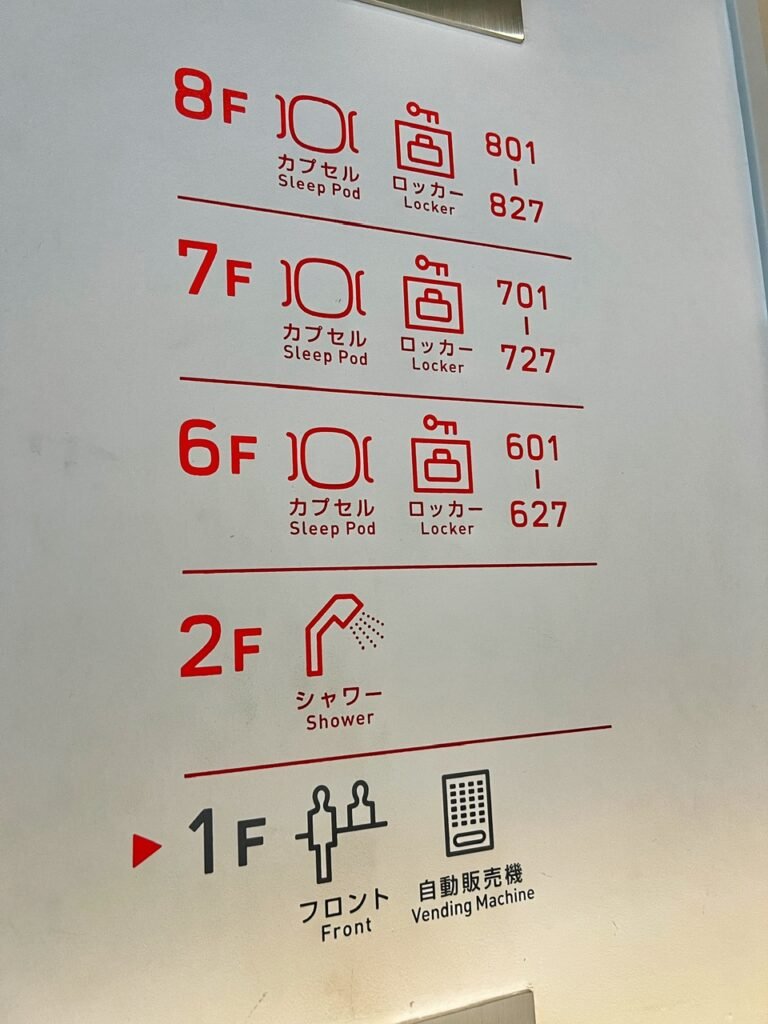
We were then immediately segregated because of our body parts. This works fantastically if you’re a solo travel. Not so well for a practically inseparable married couple with shared baggage (figuratively and literally). The women get shuffled to floors 6, 7, and 8 and men 3, 4, and 5.

When you get off the elevator, you enter a silent long corridor with rows of cubbies. When Mandy arrived, there was a young Japanese girl who looked completely perplexed standing frozen at the entrance to this row of lockers. Mandy asked if she was ok and with a bewildered voice whispered, “what do I do with my shoes?” (It’s a big no no to wear shoes indoor in Japan). These are Japanese-world problems. And there was no sign. A startling conundrum.

Turns out, keeping street shoes on, you use your key card to go to your locker. In it, you’ll find a bag full of goodies including slippers, towels, a toothbrush/toothpaste, a set of very comfortable pajamas, and finally, some sort of information on what the hell is going on in this weird place.

At 7 pm, Mandy crawled into those pajamas (which fit perfectly), as her husband settled in three floors down doing the same. She was greeted with a sense of solitary confinement….euphoric, utter silence…no other guests (yet), no partner making space odyssey commentary (that came later), and absolutely zero city noise. A complete and maximum battery recharge dream, for a very busy and inundated introvert over the last few weeks.
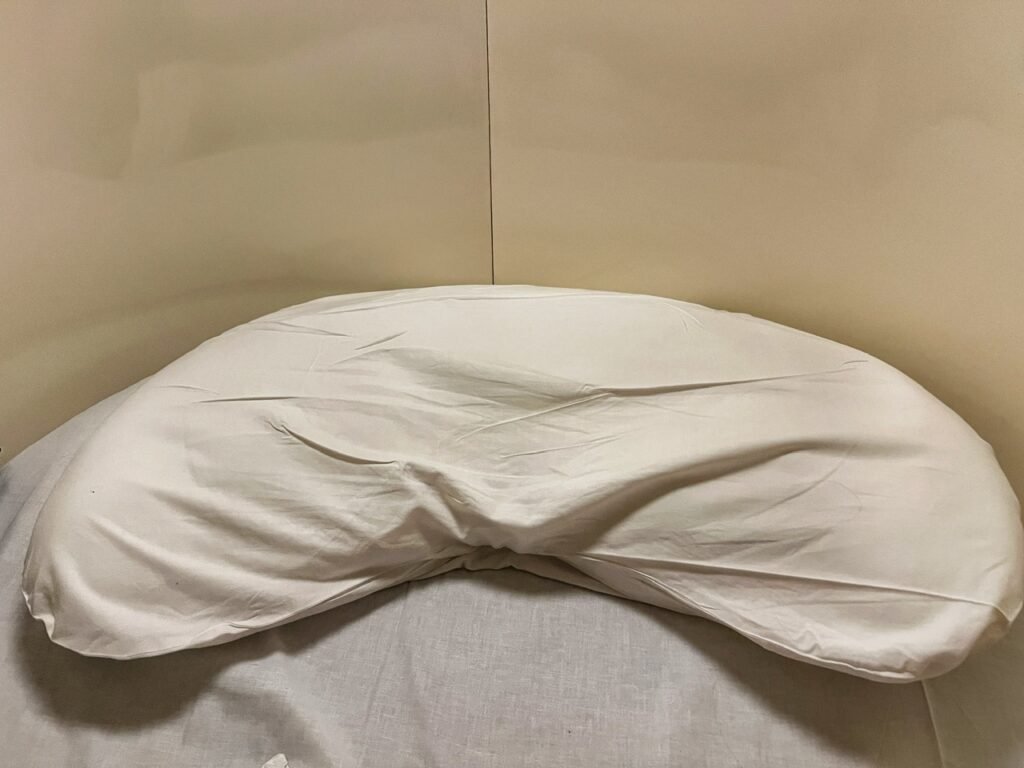
Unsurprisingly, like most pillows in Japan, these bean-shaped head holders were not great and lined with an underside of what also felt like beans, (the dry variety) topped with a layer of marshmallow. Fortunately, these were not feather like some of the other sucky pillows we had. In case you don’t know, feathers+dried legumes=neck nightmare!

If you decide to go through the hassle of taking a shower here, like Greg, it’s almost a spa-like experience, and was the best shower he had in Japan (which says a lot.) It included a blissful rain shower head with all the amenities, lots of spacious room to dress and perfect pressure and temperature. Mandy, the dirty backpacker who decided to wait until it was easier to shower, had a bit of shower envy when she found out how good they were.
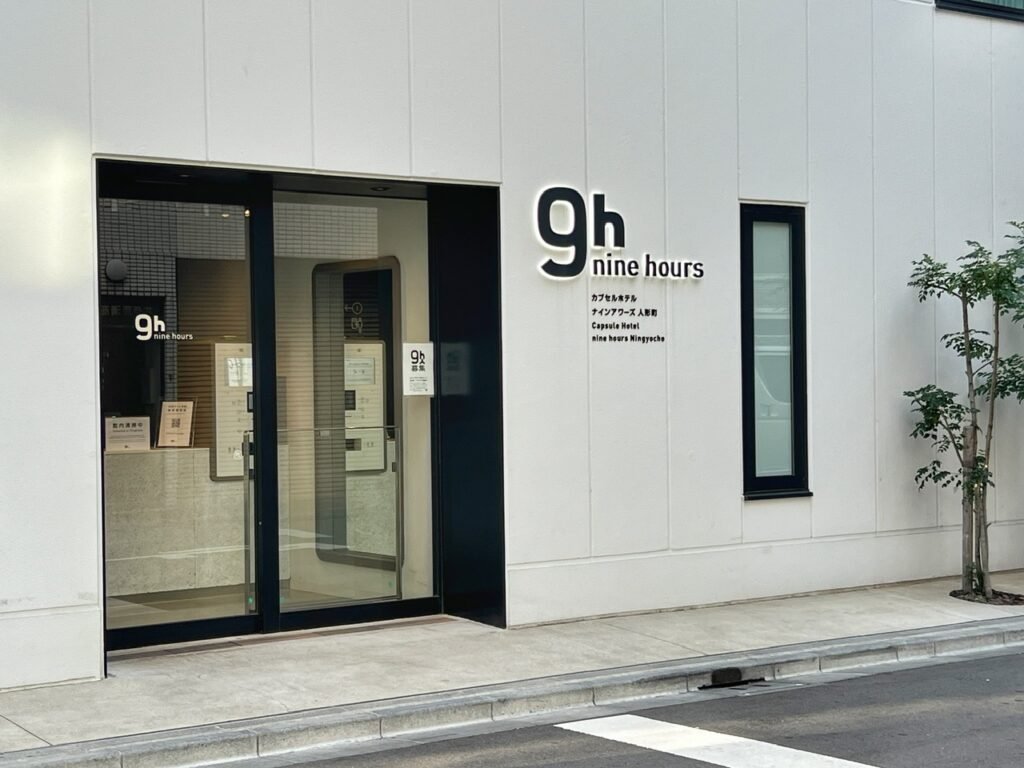
So, conclusions on the capsule hotel…fantastic for a solo traveler who wants to sleep and get clean. But, maybe not the best option if you expect anything more. We’re just happy we didn’t pay the original ticket price of $50/each. For us, that would be far from worth it. Still a very unique experience and we’re glad we got to test the waters!
Day Eleven: The Big O and Itabashi Neighborhood

Greg promised Mandy the Big O in Tokyo and damn, did that man deliver! Not only did she witness a new high, she got to perform (on top) to the best of her abilities. OMG…people…we’re talking about belting out karaoke at the top of a Ferris wheel! Get your head out of the gutter! After cooling down, we walked to have the best Japanese Curry Katsu we’ve ever had at an extremely local joint called Raisukarē Manten. We ended the dismally rainy day early tucked into our second pod in Tokyo, but one that was much cheaper, preferred and yes, less Space Odyssey-esque than the last capsule.


Only the Japanese would have the spunk to name their 200-foot (60 meter) giant centerless Ferris wheel, “The Big O.” It’s part of a small theme park at the Tokyo Dome in the northern part of the city and has a roller coaster passing through the middle, as well as karaoke in the pods. Yes, once again you can count on the Japanese to do things a little bit better than everyone else.
Pleasure pods. You get one rotation for a very reasonable ~$6/each. Considering most wheels of this kind are substantially more, it was a no brainer. Plus, you get to sing. To find any songs we knew, we had to go to “World Songs.” Unfortunately, “You Spin me Right Round, Baby Right Round” was unavailable, but ABBA saved the day.


Since Greg refuses to ever do real karaoke with Mandy, this a consolation prize. He did sing, but we’d end up in a divorce and an official demise of Explorer Genes if it was posted on the internet. However, if you know Mandy, a typical Leo, you know she loves to be on stage and is happy to act like a solo fool for your viewing pleasure. See the video in our wrap-up post.🤪 While she many be a karaoke diva, Greg prefers to be tucked behind the rolling camera. This is one, of many reasons, why we don’t have YouTube channel.



We were also excited to have the “phenomenal” view of Tokyo, said the guidebook. Too bad the weather had turned to this by the end of our stay! Although the roller coaster wasn’t running due to the weather, the log flume, and this solo rider knew it was the perfect day for a spritz as the roller coaster threads its way through the shopping mall.



After the dancing (more like wiggling) queen had worked up an appetite, we headed to Raisukarē Manten for some very local chicken katsu curry. It was 11:45 and the counter was already loaded with business suits with their heads tipped over their bowls of piping goodness. Upon arrival, there weren’t two seats together so we prepared for the split until a chivalrous man gave up his seat and relocated so we could sit together. This happened at least three times in Japan. Common courtesy is through the roof in this country…never ever seen anything like it.
This was not our first chicken katsu curry, but definitely the best and only cost $4.50/each. If you’ve never had Japanese curry, this symphony of texture is thick and creamy like American gravy but with the taste of mild, but deliciously spiced curry. It’s blanketed over rice and panko-crusted chicken (or pork.) Add a layer of peppers to spice it up, and you’ve got the ultimate cold, rainy day comfort dish. Mmmm.

We confirmed this place was a hidden gem when we saw the line, despite the rain soakage.
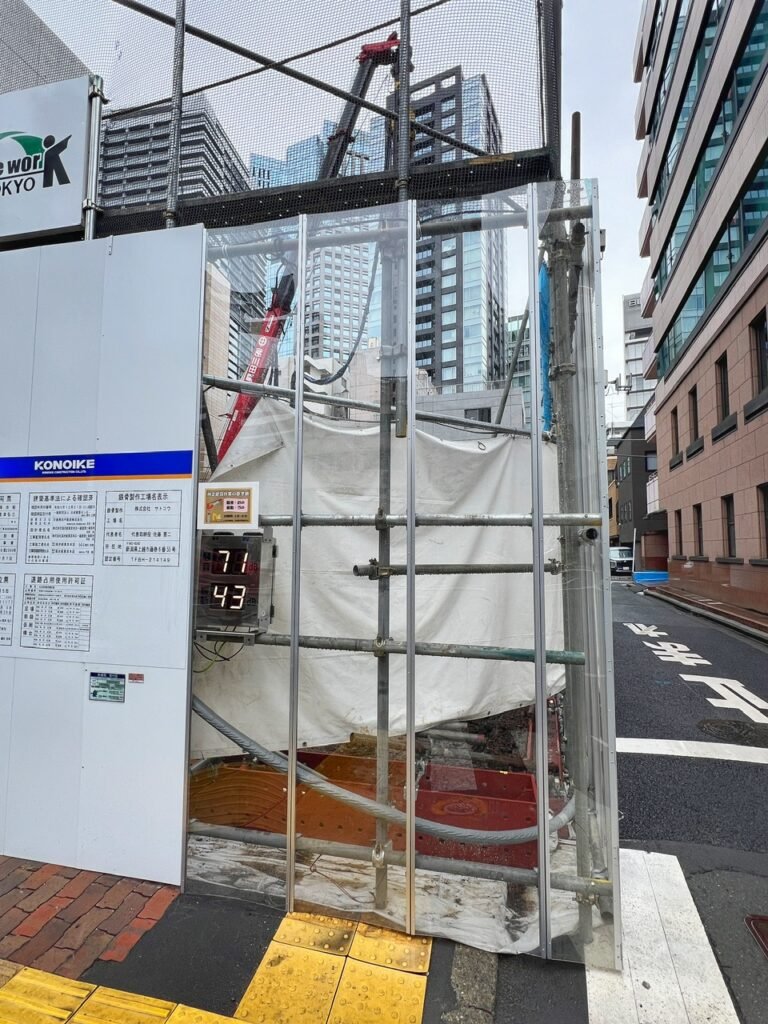
More things that make Japan a refreshing follow up to Latin America… decibel meters to ensure construction sites don’t get too jackhammery.

Moving toward our next accommodation, we encountered a series of green pipes which have snaked their way through lidabashi subway station. According to Atlas Obscura, this intricate network of fluorescent green pipes was designed completely by a computer.
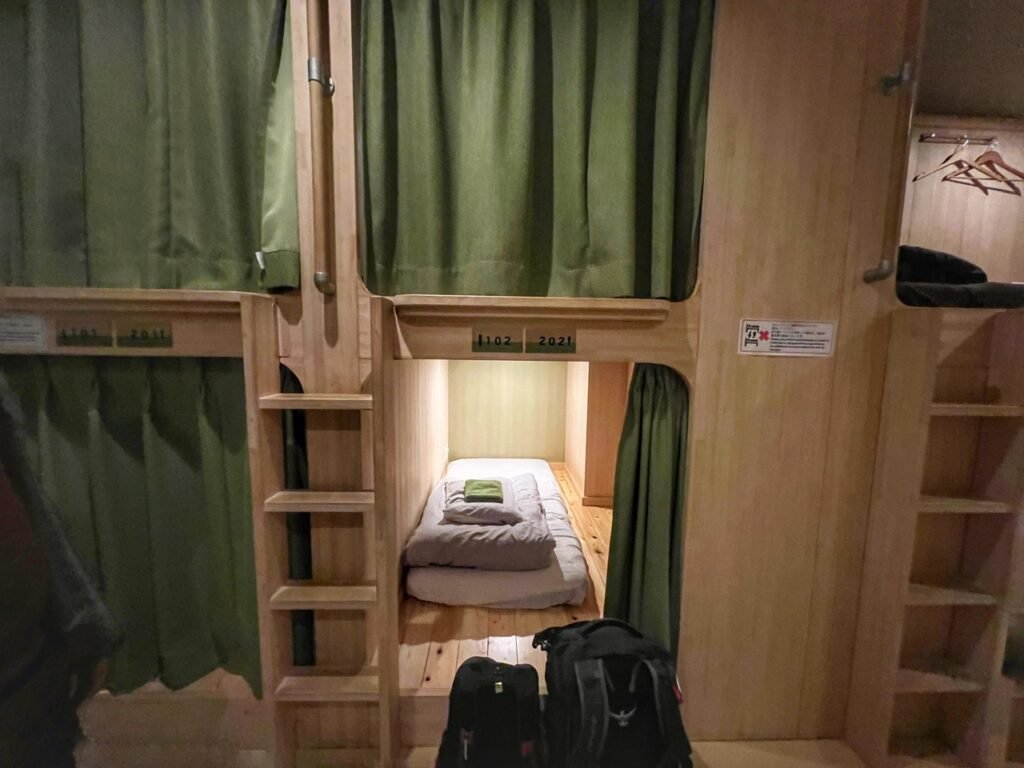

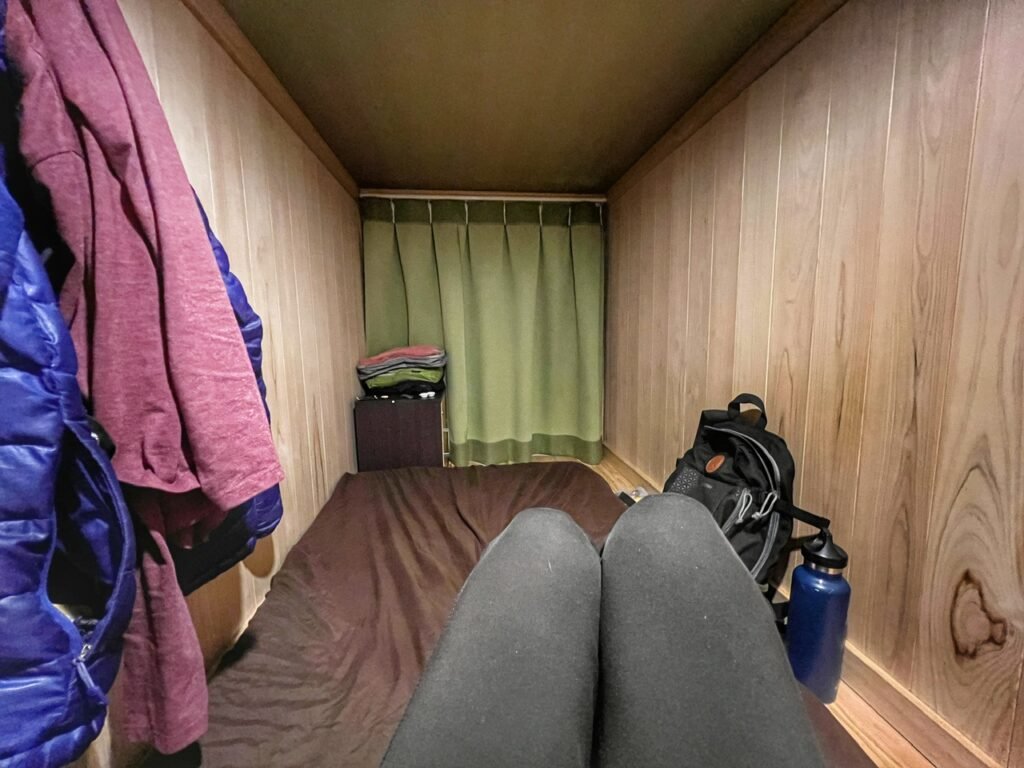
For our 11th & 12th nights in Tokyo, we moved north to the Itabashi neighborhood. Here we were able to find cheaper accommodation, paid at full price, at “Lodging Tokyo TJ03” which was probably the best value we had at $26/night for two pods. It had a shared kitchen as well. (Booking)
These were even more spacious than Nine Hours and also allowed us to be near each other rather than segregated by floors. (Unless you count the top/bottom division.) There was lots of room for stretching out and storage, although the lockers were only big enough for small valuables. It was also very intimate and quiet, although further from the main attractions. Definitely recommended!
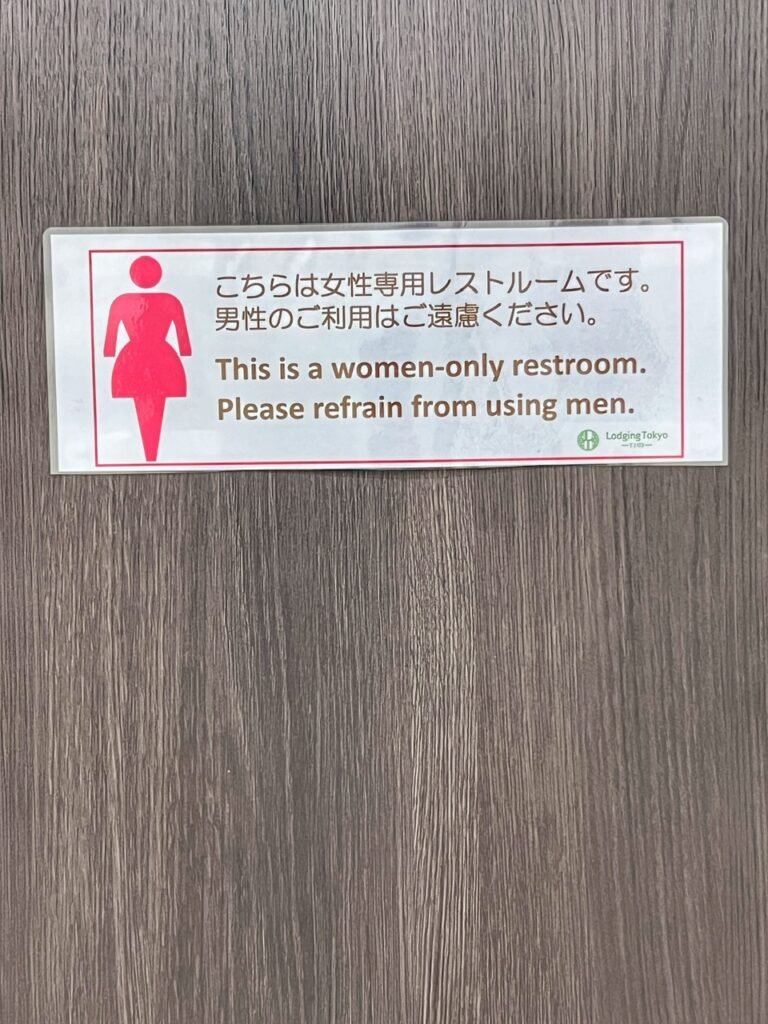
The bathrooms, as always, had heated toilets, amazing showers, and amusing literature to read.


The neighborhood of Itabashi was also very pleasant and had a tranquil neighborhood feel. We’d definitely stay here again. Shopping for breakfast food, we stumbled across a sippy box…of sake…for $1! Wow, this country continues to amaze! 😯
Day Twelve: Shinjuku City

Believe it or not, we waited until the final day for a proper dip into the pulsing heart of Tokyo…the modern, vibrant, bustling and touristed district of Shinjuku. Here you will find a sea of radiant lights, the most gigantic cat licking its…never mind…, a charming street devoted to meats on sticks, a fantastic free 45th skyscraper view of the city, and the world’s busiest railway station, handling more than two million passengers every day.
Shinjuku Kabukicho street is the Las Vegas meets Bangkok of Tokyo…the location of many host and hostess clubs, love hotels, the disturbingly “cutest”(?) red light district we’ve ever seen, shops, restaurants, and nightclubs. For this reason, it’s often called the “Sleepless Town.”
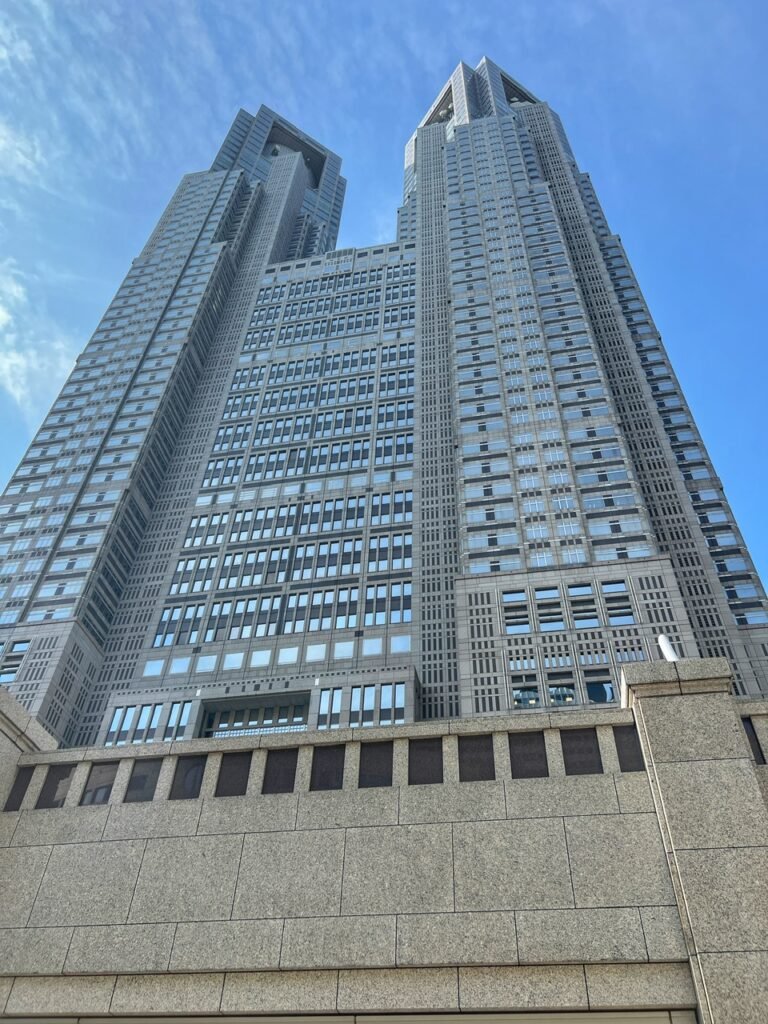
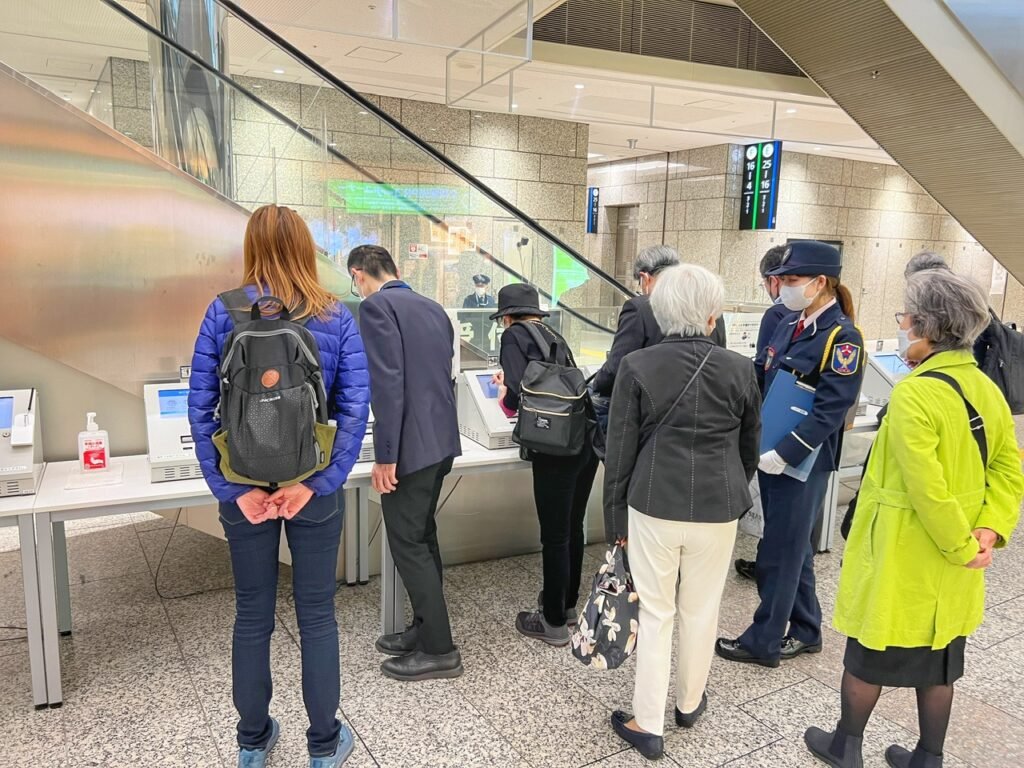
We started our day by heading to the Tokyo Metropolitan Government building, an iconic building housing exactly what it sounds like…but here government employees might actually have a chance of making a difference. Tourists are welcomed to head to the 45th floor for free views of the world’s biggest city after a welcome to the building and registration. Coincidentally, it is closed the third Tuesday of the month, which it happened to be, so we only got to go to the 35th floor to the employee cafeteria, which is also open to the public. They only ask you to buy something.


While there, you have the possibility of a glimpse of Mount Fuji on the skyline, which definitely did not come out to play for us. You also get to soak in 360 views of the surrounding city while you drink an $.80 coffee….
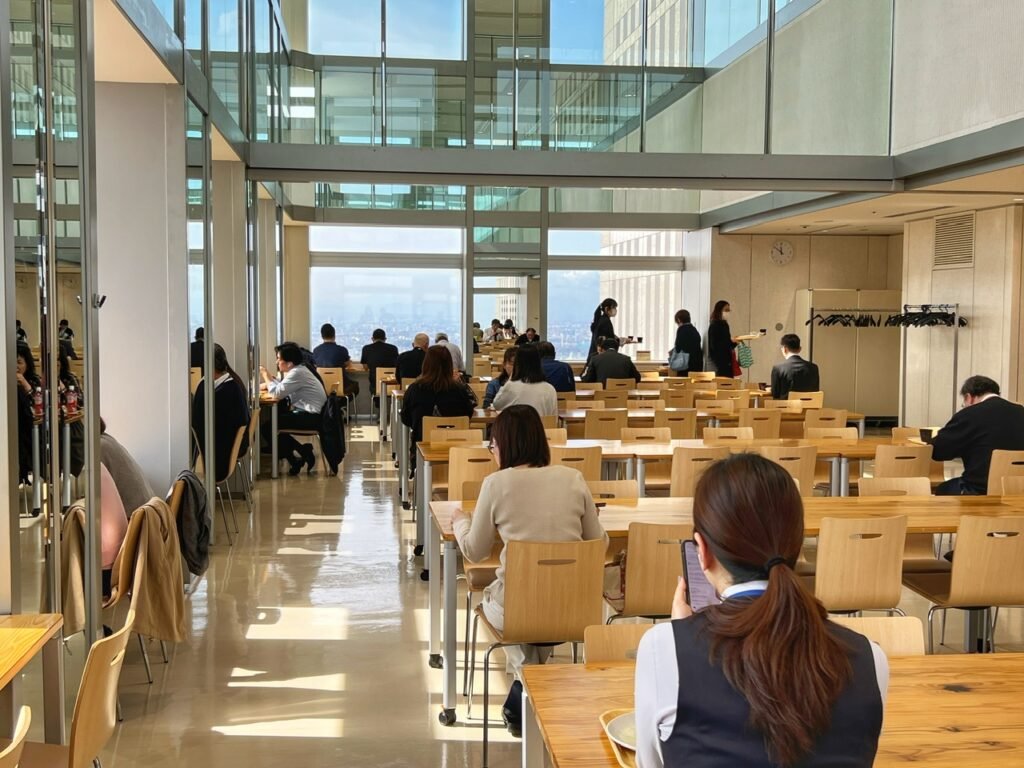

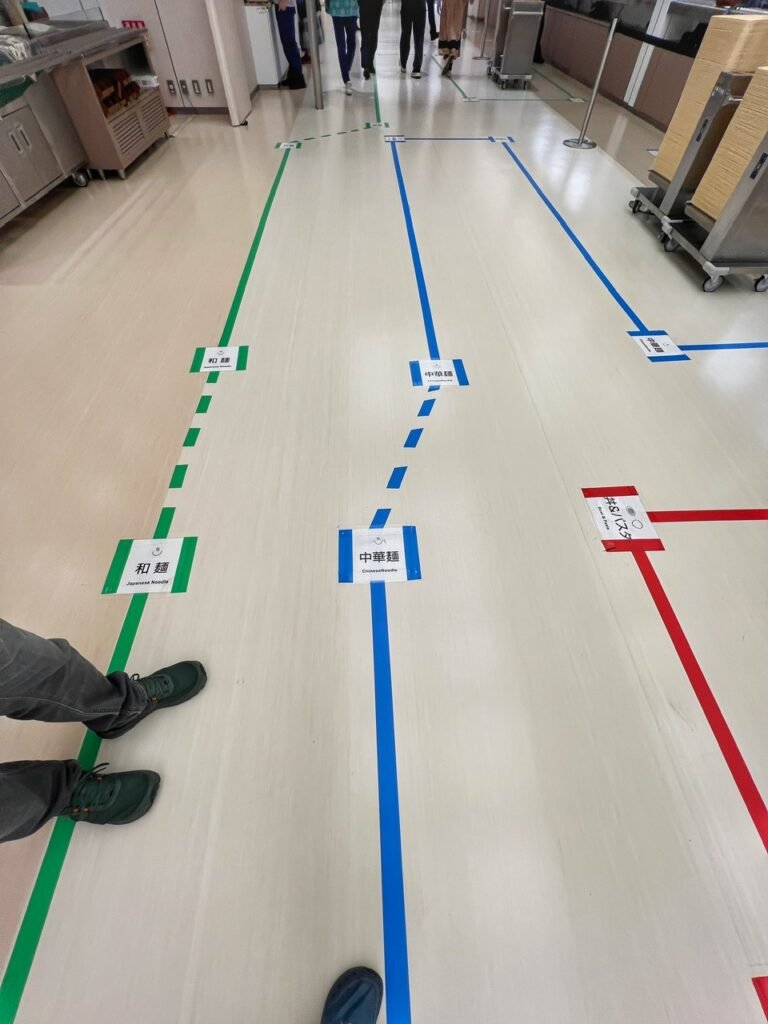
…and surround yourself with Tokyo governmental employees in an environment that feels more like a library than a cafeteria. We did consider buying a set lunch which cost a very reasonable $3-$5, but we were a bit early. However, we were quite impressed with all the options including organized floor lanes depending on what food item you’d like to digest that day.

Uh huh. So this is the reason nobody is talking?!

Moving into the streets of Shinjuku, we meet this nail file-looking building called Mode Gakuen Cocoon Tower for the first time which is the second tallest educational facility in the world.


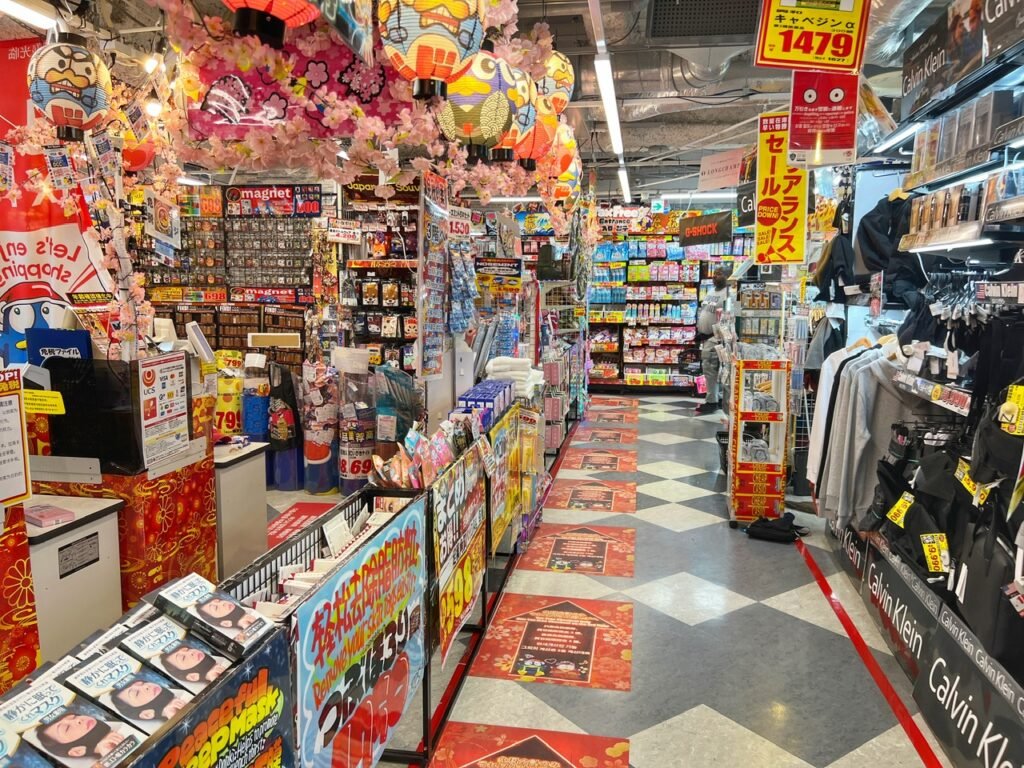
We then wandered into the five-floor Don Quixote department store, renowned for being a tourist shopping favorite. Although the prices for alcohol were through-the-roof cheap for Japan, (why the tourists probably like it), we found the store to be visual chaos and overstimulation, much preferring the store “Hands.”

Beginning our walk around Shinjuku, we were surprised how empty the streets felt.
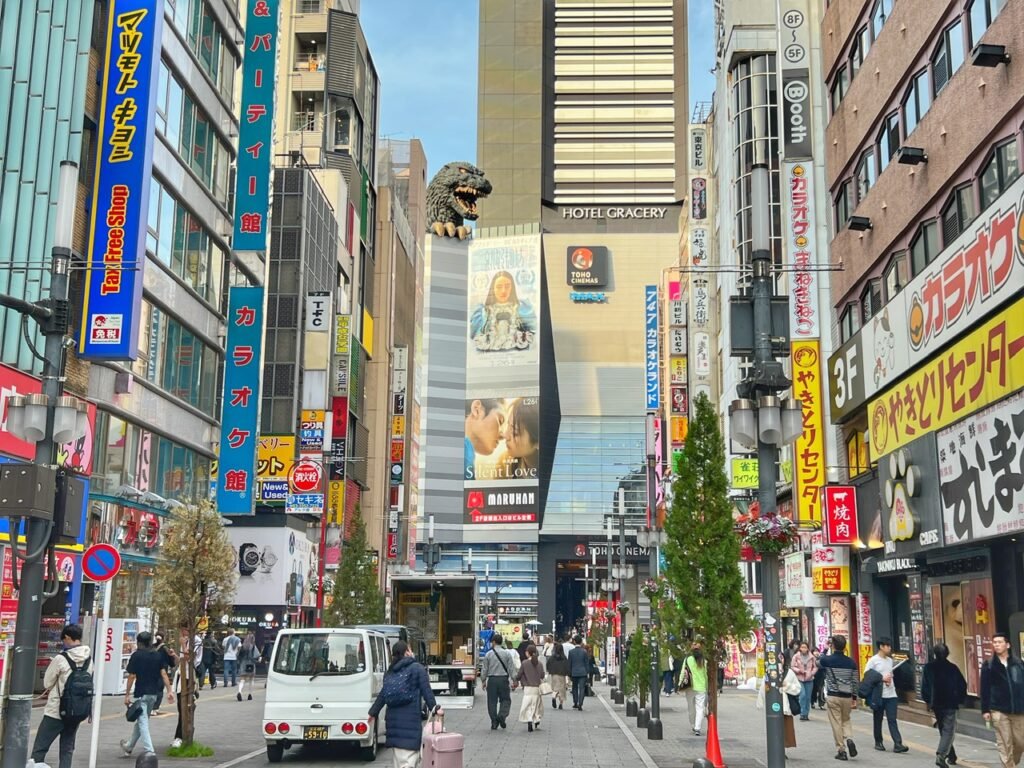
Godzilla must have scared everyone off. Bad monster! Did you know that Godzilla was conceived in 1954 as a metaphor for nuclear weapons in the wake of the atomic bombs of Hiroshima and Nagasaki?! Apparently, you can go up into the 8th floor of the hotel to see him up close for free, but we decided to skip it.
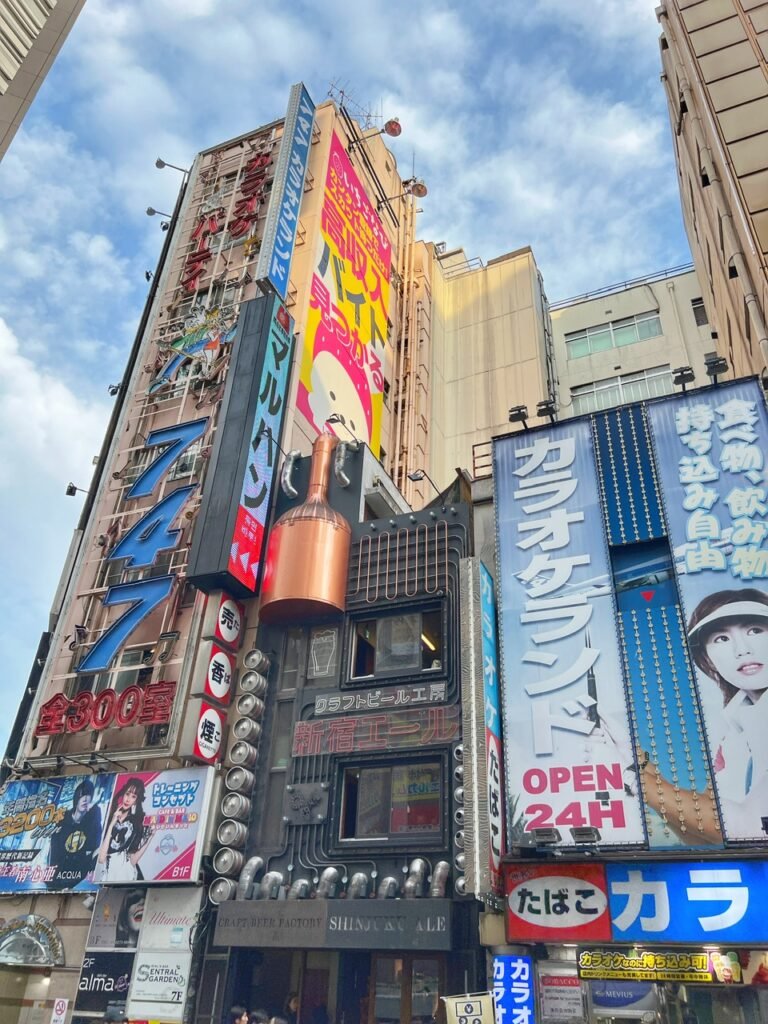
What a funky brewery exterior!
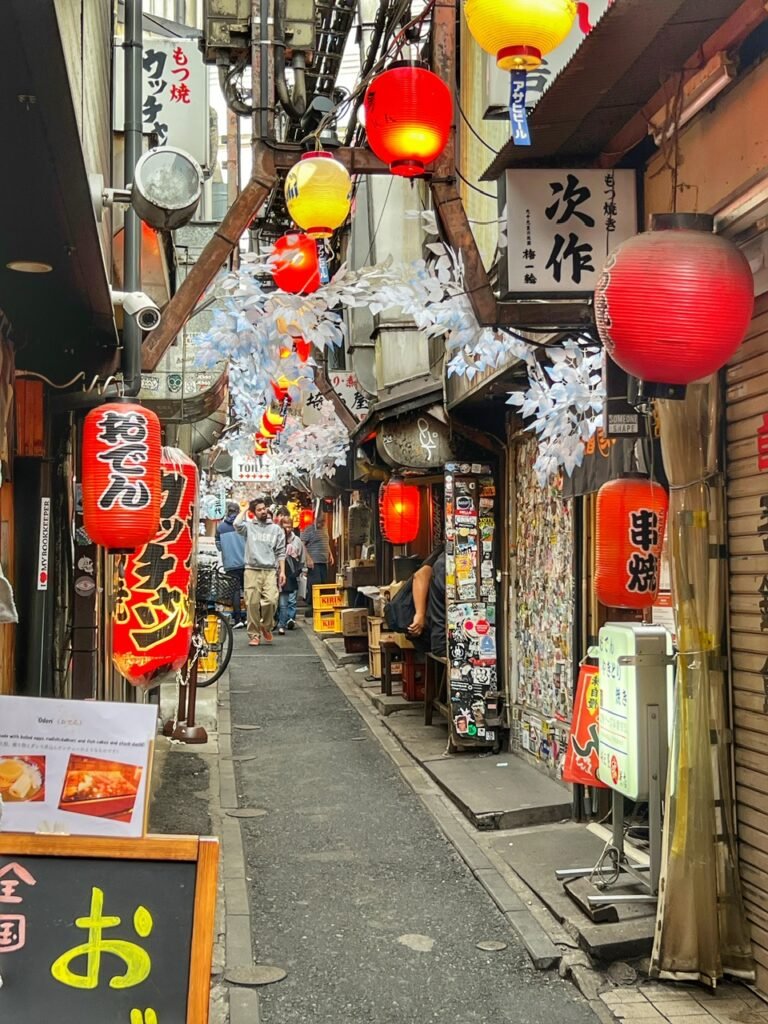
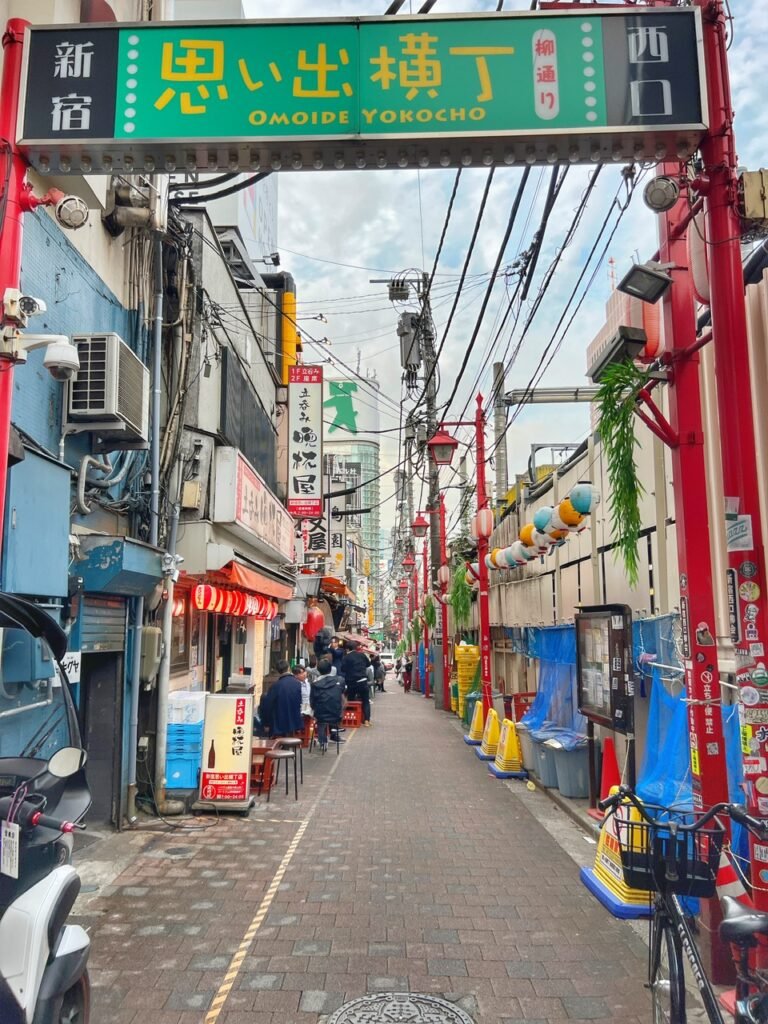
We then wandered into Omoide Yokocho, a maze of charming alleyways in Shinjuku, which roughly translates to Memory Lane. It’s an area of nostalgic reminiscence, dedicated to overpriced meats on sticks (yakitori and kushiyaki) as well as nightlife.


According to the Japan Experience, “the area started out as a huge black market close to Shinjuku Station in the days right after World War II. In those days, it was certainly dangerous to visit the area – but hardly anyone had a choice. Here was the food, here were the supplies.” Today, like most of Japan, it is completely safe…


…although you need to watch your wallet. These meat sticks, and the accompanying cover charges to sit or stand at the counters, are crazy overpriced compared to elsewhere in Tokyo. So don’t fall into the cute trap and warm welcomes in English trap! You also need to watch your arteries.



Instead, after trying and failing to find vegetarian ramen on several counts, we grabbed some udon noodles at an eatery nearby, where you fill your bowl with toppings of your choice as well as your own dashi broth. Really delicious! Not so delicious was the pickled plum we tried for “dessert.” This was Mandy’s face after that.
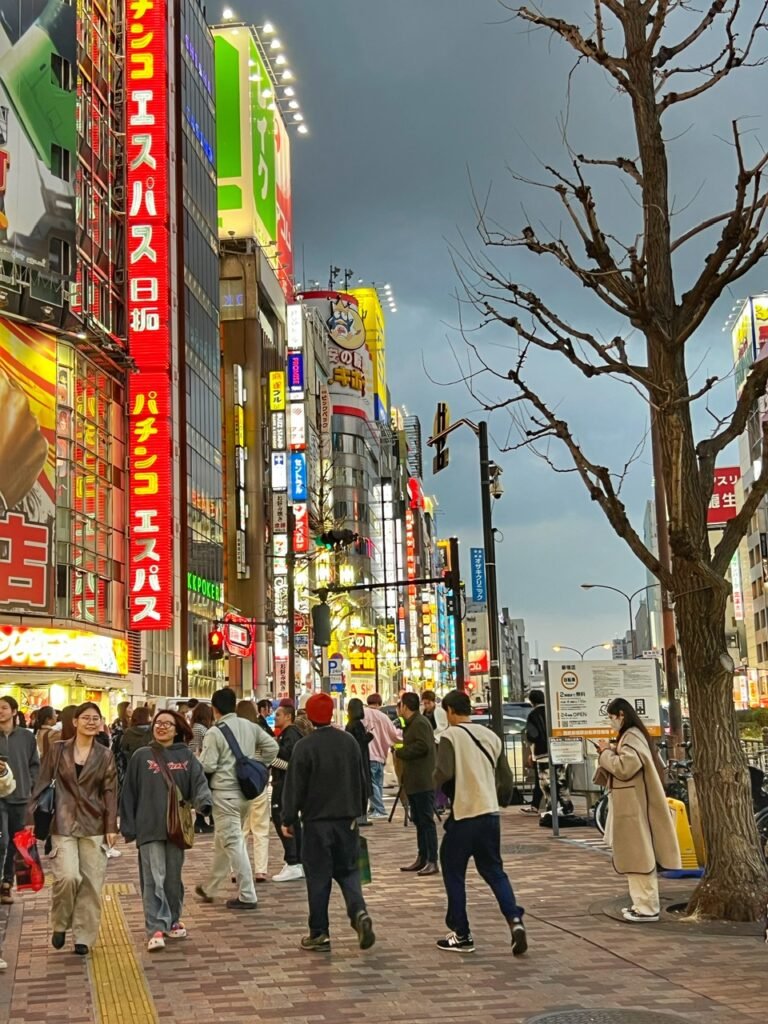
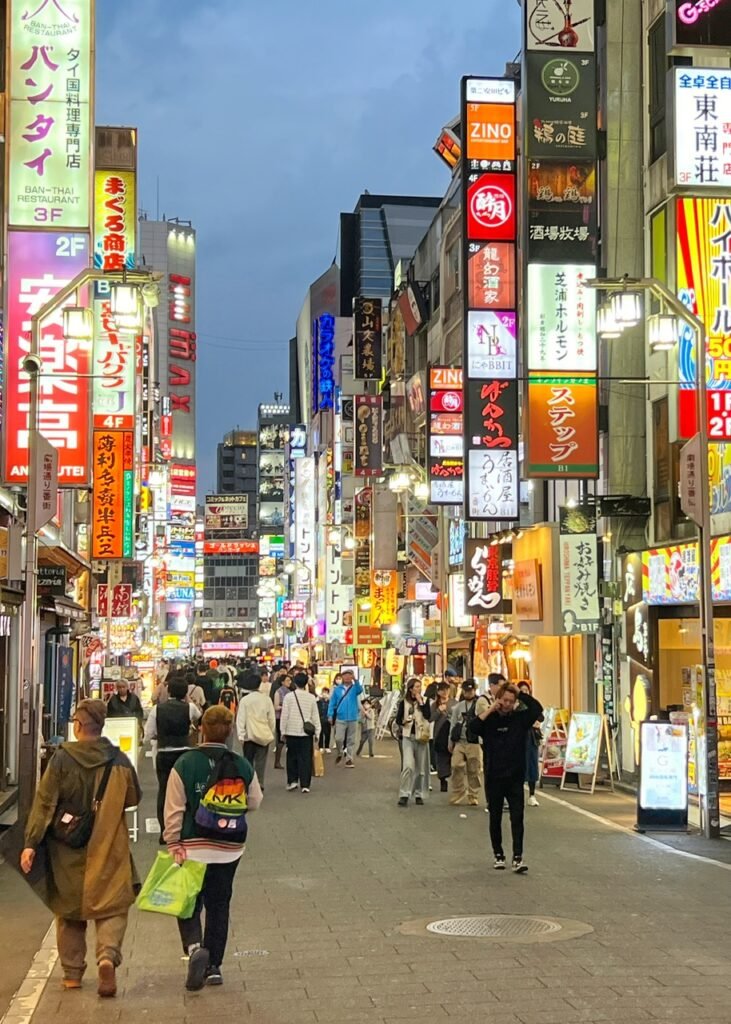

Heading back out to Shinjuku to get our taste of nightlife until it was time to head back to greet our 10:00 bedtime. Everywhere you walk, it’s an absolute amusing spectacle.

For example, although it would be impossible to identify the cutest thing in Tokyo, this 3-D megatron feline promoting the cat cafe across the street may easily be in the running. Maneuvering himself into both endearing and obnoxious poses that all cats do, he draws quite a crowd on a regular basis, all laughing and aww-ing in unison. Not sure if the crowd or the cat is more entertaining though.😹



At about 7:00, we wandered over to Golden Gai, a complex area of narrow alleyways area clustered with diminutive bars, many no bigger than most Americans’ closets. Naturally, most of the bars were still closed at our early bird special arrival time and didn’t seem like they’d be opening for at least 2-3 more hours.
Although it’s surprising the guys at Death Match in Hell, a metal bar selling beers for 666¥, wouldn’t open early for us super badass American 40-somethings.
In fact, although there was very little life going on anywhere at that moment, the quiet atmosphere with the lanterns and piss-free alleys was pretty alluring. We also could see how the Greg and Mandy of 20 years ago might have been very into bar-hopping in this unique place.


But alas, we’ve got silver glitter in our hair now, so we bid the solitude farewell and went to instead silently crowd-surf the Shinjuku metro at 7:30 pm, aka rush hour. (Yes, rush hour lasts well until 8:30 in Tokyo.) But look at all these rule abiders in neatly organized queues!

The next morning, well rested and without hangovers back at our capsule hostel, we finally enjoyed our first Japanese strawberries. Because we were staying out of the center (we suspect) and went to a regular supermarket, they were much cheaper and cost around $4. And we have to admit, delicious. Not Hood River, Oregon delicious but pretty close.

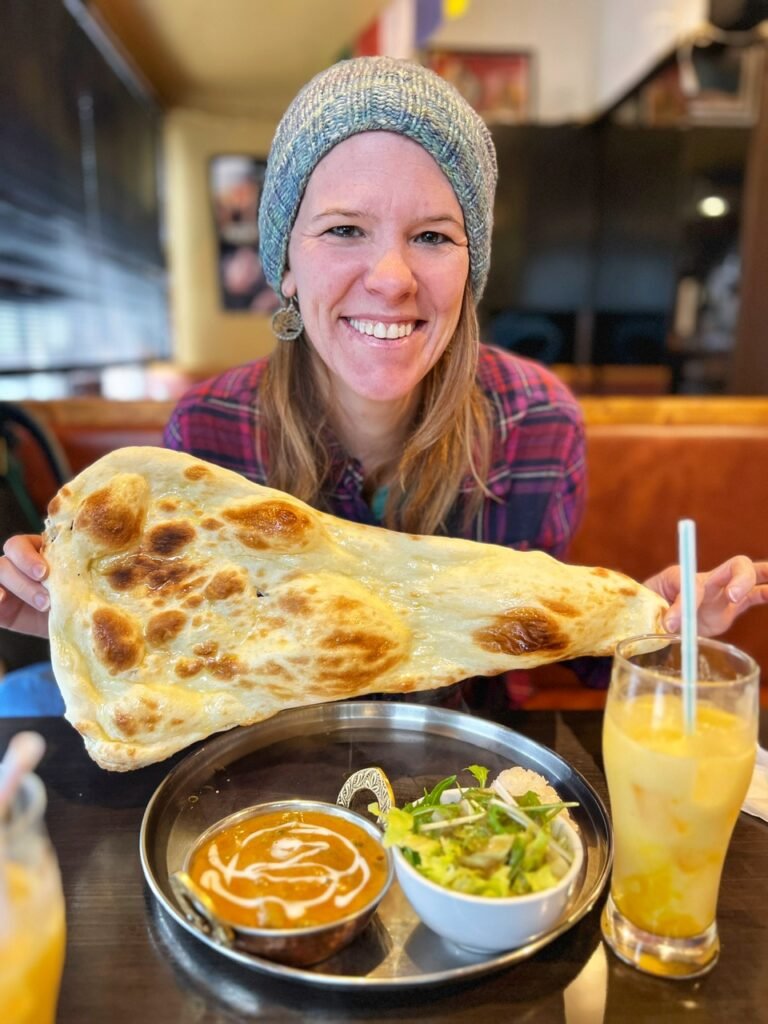
By our last meal in Tokyo, believe it or not, we were burnt out on sushi and trying to find things that didn’t have red meat, so we went to Newa Kitchen for some mouth-watering Indian and Nepalese food. It never fails to be one of the world’s best. Yum yum yum! The guy that served us this mega piece of naan bread was a 20-something immigrant who had relocated to Tokyo 10 months prior. We were simply floored the way he shifted from Nepali in the kitchen to English with us to Japanese with other customers, three vastly different languages. This world, and its determined people, never stop amazing us.
Day Thirteen: The Airport Town of Narita

For those heading to or from Tokyo, don’t discount spending a little time in the airport town of Narita, an hour east of the city. In addition to a plethora of mandatory airport hotels, here we surprisingly discovered the most beautiful Buddhist complex we saw during our time in Japan…the centuries old Naritasan Shinshoji Temple, which featured gilded golden pagodas and tranquil gardens which cast an eerie beauty on the rainy evening we went. We also love the color pops of these ornamental plants that look like a blend of cabbages and kale.

Also, flowing between Narita train station and the temple is Omotesando, a narrow street lined with colorful shops and restaurants in the style of Japan’s Edo period.
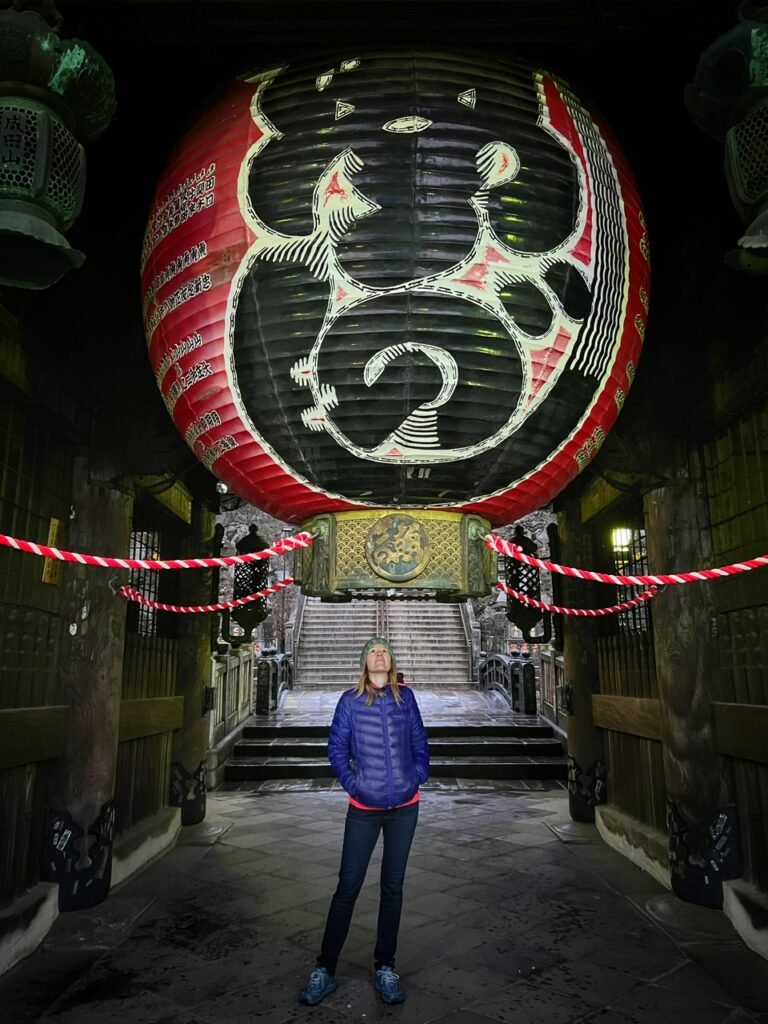

How many Mandys would that lantern hold at the opening gate of the temple complex.


The walkway toward the main temple which looks like giant chess pieces. Depictions of dragons are used throughout the Japanese culture as symbols of strength, courage, and magic.


The main temple and three-storied pagoda. This pagoda was built in 1812. The ends of the immaculate rafters also have dragons on them.

The tranquil garden of Buddha
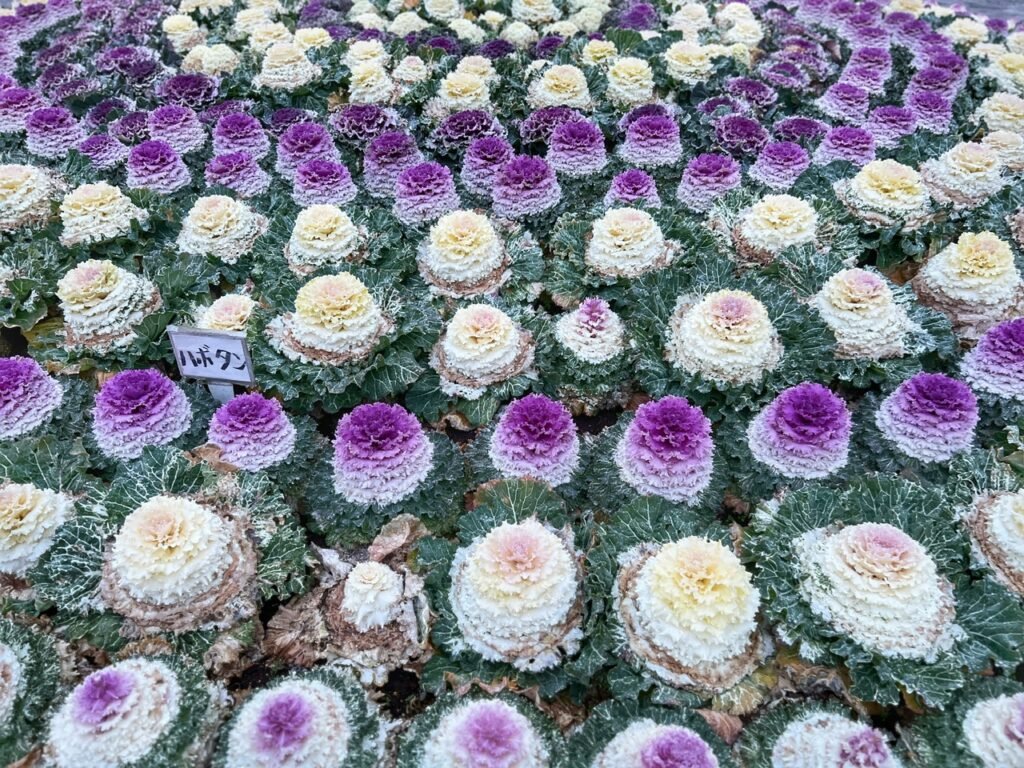

Some color to brighten up the grey. But the grey and rain does make it kinda dreamy…

Unbelievable. How on earth did they create those curves during that time?
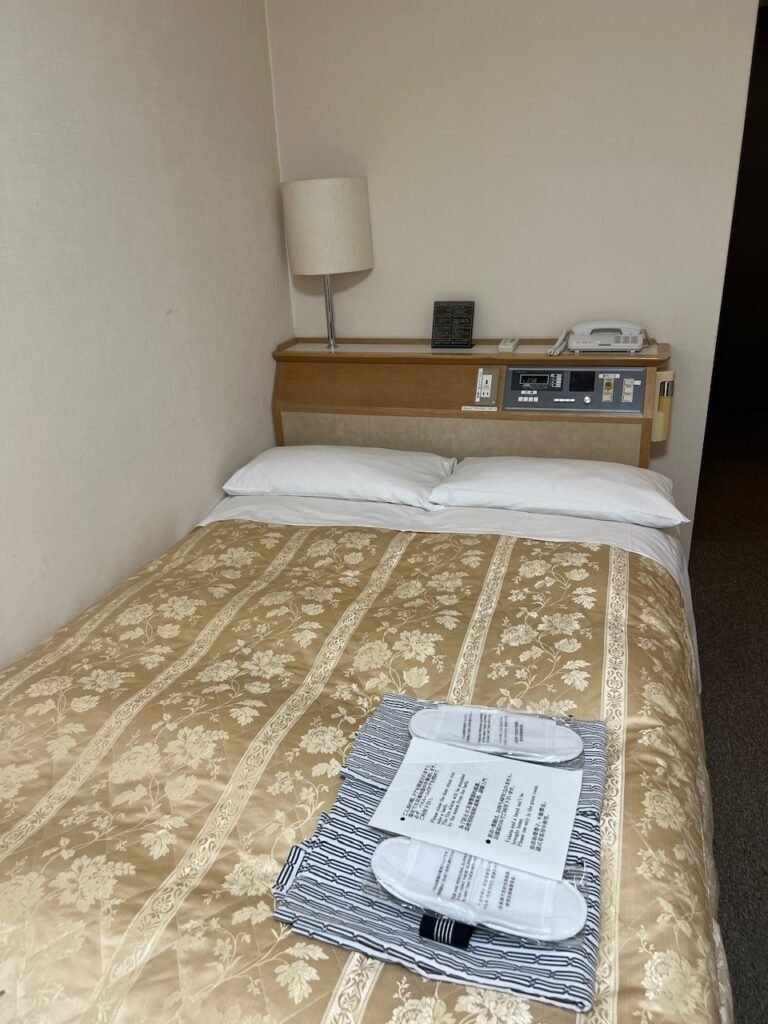
We stayed at hotel called Narita U-City Hotel which was also a blast from the past. ($39/night) Not sure if the comforter had been updated since the 70s, although fortunately the sheets had. It also hilariously had archaic room, bed and alarm controls on the headboard, kimonos/slippers, and the usual throwaway toothbrushes, combs and razors (grrr….Japan!!!)


On our way out at the airport, there were a few more innovations to point out…a quiet room for people with autism or disabilities and a flap on the bathroom floor so your bag doesn’t get dirty (on the spotlessly clean floor.)

One of our snacks for the flight because we were craving some dairy…bite-sized cheese snacks called “Candy Cheese.” Disappointingly it was also individually wrapped like candy and tasted worse than Cheez Whiz. Don’t think we’ll be getting our proper cheese ration anytime soon.


